with 🎙️ Paul O’Callaghan – Founder & CEO @ BlueTech Research
💧 BlueTech Research analyzes innovative water technologies to transform your company.
💧 Paul is also the executive producer & co-director of Netflix’s “Brave Blue World.”
💧 … and as he noticed, that he still had some time on Saturdays, he just completed a Ph.D. on the Dynamics of Water Innovation!
This episode is part of my series on (successful) Water Entrepreneurship – check it out! 😀
What we covered:
🍏 How long and what stages it takes for Water Innovations to exit the no man’s land and cross the chasm
🍏 What are the milestones you shall identify on your path to guide you on the quest to mass market
🍏 Three Key Fields that attract 73% of investments to jumpstart your water venture
🍏 Key Hints on the best ingredients to get your water innovations adopted by the early and late majorities
🍏 How to get Netflix, Liam Neeson, Matt Damon, and Jayden Smith to root for a Water Project
🍏 How claiming to bring innovation to life is as broad as saying you want to get a gold medal in the Olympics – you need to know first in which sport you’re competing
🍏 How “Done” is better than “Perfect” and how “good enough” approaches may solve big hurdles in the Water Sector
🍏 How and Why there’s more money spent in California every year on bottled water than on utility water
🍏 How everything looks like a nail if you only have a hammer – aka we might need new paradigms to solve the upcoming water challenges
🔥 … and of course, we concluded with the 𝙧𝙖𝙥𝙞𝙙 𝙛𝙞𝙧𝙚 𝙦𝙪𝙚𝙨𝙩𝙞𝙤𝙣𝙨 🔥
How Water Innovation may Create Unicorns
Teaser:
Resources:
➡️ Send your warm regards to Paul on LinkedIn
➡️ Visit BlueTech Research’s Website
➡️ Read Paul’s Ph.D. Thesis on the Dynamics of Water Innovation
➡️ Get to know more about the Brave Blue World Documentary

is on Linkedin ➡️
Infographic: Water Innovation
LinkedIn-Infographic-1Table of contents
- What we covered:
- How Water Innovation may Create Unicorns
- Teaser:
- Resources:
- Infographic: Water Innovation
- Full Transcript:
- BlueTech Research in a Nutshell
- Brave Blue World: Joining forces with Netflix, Liam Neeson, Matt Damon and Jayden Smith
- The Dynamics of Water Innovation – Paul’s Ph.D. Thesis
- Is Venture Capital compatible with Water Innovation?
- Water Innovation and R&D Funding
- “Disruptive Innovation” is an overused buzzword
- Value-Driven Vs. Crisis-Driven Water Innovation
- WaTA – Understanding how Water Innovations get accepted
- It takes 30-40 Years for a Water Innovation to get adopted
- A dense jungle of Water Innovations
- Universities, Schools and Books are laggards when it comes to Water Innovation
- The more you understand a Water Technology, the faster you adopt it
- Innovation in the Water Industry involves rethinking Business Models
- Does Water Innovation tick at a particular pace in Japan?
- How to find early adopters for your Water Innovation?
- Are there shortcuts to Water Technology adoption?
- How to tell a compelling story to leapfrog Water Innovation
- Reaching the General Public to advance the UN Sustainable Development Goals
- Is Water considered right on the path to Sustainable Development?
- Why did never any Water Innovation grow as a Unicorn?
- Could “Good Enough” approaches accelerate the reaching of the UN Sustainable Development Goals?
- How California spends more on bottled water than on utility water
- Can the CoVid 19 Crisis help adopting Water Innovations?
- The three technology fields that attract 73% of Investments in Water Innovation
- Rapid fire questions.
- Other Episodes:
Full Transcript:
These are computer generated, so expect some typos 🙂
Antoine Walter:
Hi Paul, welcome to the show.
Paul O’Callaghan:
My pleasure. Thanks for having me.
Antoine Walter:
Well, actually we have a very packed schedule, so I’m going to start to very, very swiftly with the, with the postcard and you are sitting in cork Ireland right now. What can you tell me about cork that I would ignore by now?
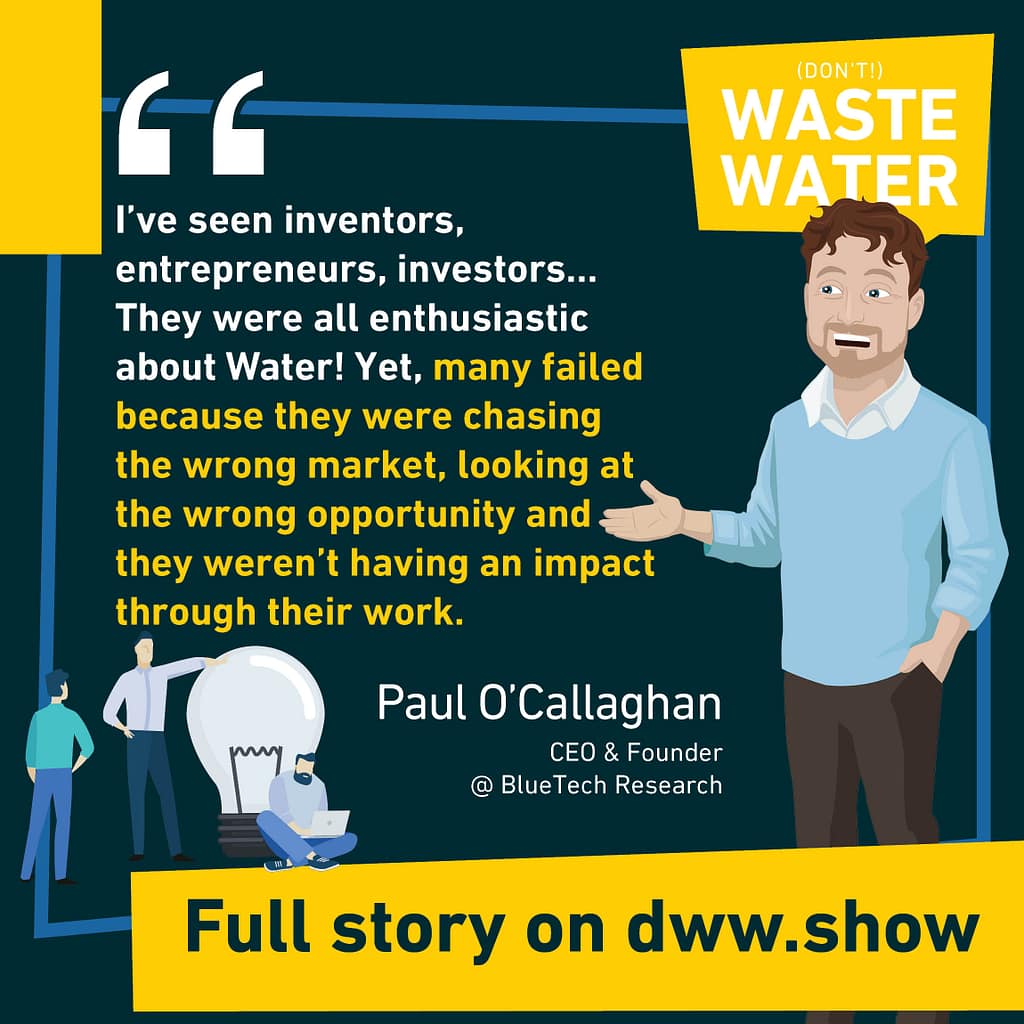
Paul O’Callaghan:
Well, it’s very beautiful. It’s probably, as people imagine on a postcard it’s green, it gets plenty of rainfall. It gets probably more sunshine than people might think we’re near the ocean. So what’s become very popular here during COVID-19 is people are actually swimming a lot in the ocean on your own. Believe it or not even in the winter now. So yeah, it’s an exceptionally lovely part of the world to live in. We’re intimately connected, being on an island with the environment around us, oceans and rain, and it kind of encapsulates a lot of my interests in life. I can do snorkeling and swimming and kayaking and all that.
BlueTech Research in a Nutshell
Antoine Walter:
Okay. So now you’re really trying to make me jealous and that worked. That’s a good start, actually, Paul, there’s a ton of reason why I should have invited you. And if you have three more hours, we can cover all these reasons, but we have to be a bit focused. Let’s start with everything we won’t be addressing today. And the first thing we won’t be addressing today is actually your company, BlueTech. What can you tell me about BlueTech? What is the gap in the market that you were aiming to close with? Bluetech
Paul O’Callaghan:
No, I’ve been in the sector for about 20 plus years now. And you know, when I was younger and I was working in different parts of the industry, always noticed that everyone was so enthusiastic and water. They all wanted to make a difference. There was on Venters entrepreneurs, investors, and yet many of those startup companies failed because they were chasing the wrong market, looking at the wrong opportunity and they weren’t having an impact through their work. And I thought that’s, that’s a pity because these water challenges are, are huge. And there’s only a certain amount of human capital that we have to make a difference. And if we could do one thing with BlueTech and it’s to help make people more efficient, to save them a year, to save them, you know, wasting funding on pursuing an opportunity, that’s not going to be profitable or created value for them.
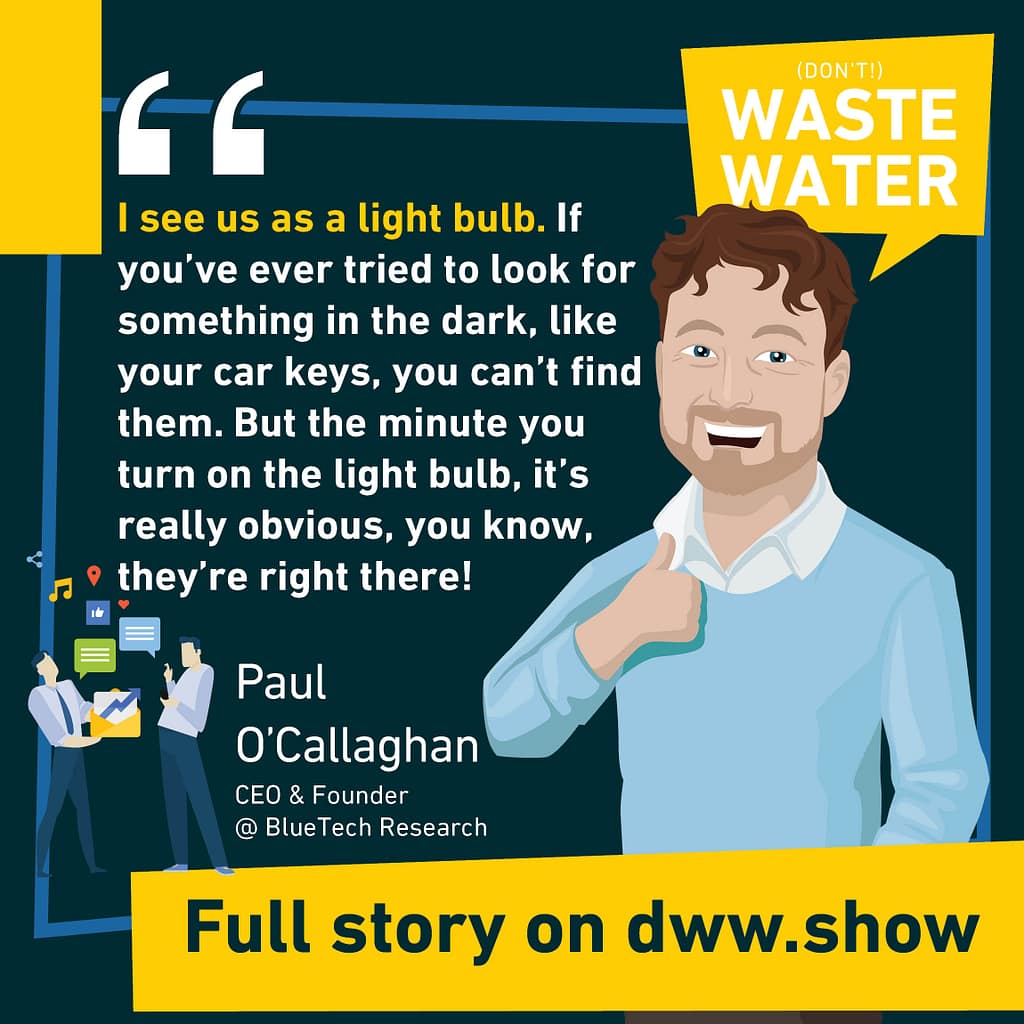
Paul O’Callaghan:
That would be a good service. I think I view us like a light bulb. You know, if you’ve ever tried to look for something in the dark and you’re trying to look for your car keys, you can’t find them, but the minute you turn on the light bulb, it’s really obvious, you know, they’re right there, but no amount of fumbling was ever going to find them. And I think what we do is we bring water technology experts and we apply the science to the study of trying to understand truly does a technology solve a problem in the water sector, if so, what, and to help companies make good decisions in a nutshell. That’s it.
Antoine Walter:
So when you say that the company shall make better decisions, is it any kind of company that you support is it’s more of the new entrants into the market, the small players that want to be big players, or what’s your typical company you help?
Paul O’Callaghan:
It all started with working with the smaller companies, working with startup companies, because I realized I could make a real difference to them. And that broadened out to working with investors, venture capital investors who are becoming very interested in water. Ultimately the larger companies realized that they needed to be innovating and they were curious to know, where should we invest? Who should we partner with? And nowadays we actually work with a lot of end users like water utilities, large corporations and food and Bev and tech and other areas where they’re trying to figure out how do they get to zero water impact in the next 10 years? Like what solutions should they be using in their factories or their organizations? So it’s really right across the value chain from research institutes, investors, entrepreneurs to larger water technology firms. And as I say now, increasingly the people who are trying to solve problems in their own businesses as well.
Brave Blue World: Joining forces with Netflix, Liam Neeson, Matt Damon and Jayden Smith
Antoine Walter:
Well, very interesting that gives us kind of an understanding for the deep dive we’re going to have about this innovation. But right before we go into the deep dive, actually probably the prominent reason why I should have invited you for your, your, your most recent news as this incredible brave blue word documentary that was airing on, on Netflix. I mean, it started some month ago and I rewatched it as I was explaining you just before we, we hit the record button, I was rewatching it with my daughter just to just yesterday evening. So how’d you get Liam Neeson, Matt Damon and Jayden Smith and Netflix across the same table to build a documentary that since then broadcast it everywhere, translated into 29 languages about water. What’s the trick. How do you manage that?
Paul O’Callaghan:
I think the appetite was out there that people wanted to move on from the doom and gloom narrative about water and the apocalyptic tales that we hear and people were really ready to tell a different story, because those of us who are in the sector, we know that there is a different story here. There are solutions to these challenges of our solutions to these problems. And you know, there’s a few times in your life when you start something and you realize that the universe is almost willing to project into existence, it felt from the get go that, you know, I was pushing on an open door that things were conspiring to help make the project happen. And I think it was just that appetite that people like Matt Damon, who really cares very passionately about water and has spent a lot of his career, you know, when he’s not working in the film industry, focusing on this same with Jayden Smith, young man who was very impassioned to want to make a difference in other parts of the world, but also back in closer to home. And for Liam Neeson, it just really resonated with him. He likes the characters in the story. He liked people like Beth, who he could relate to and thought, God, this is a story we have to tell. So I think it starts by asking, okay, we knocked on doors and we persevered. But I think also the fact that we were telling positive stories and ones that were about more solutions and what we call the lighthouses in the film, I think that made a difference.
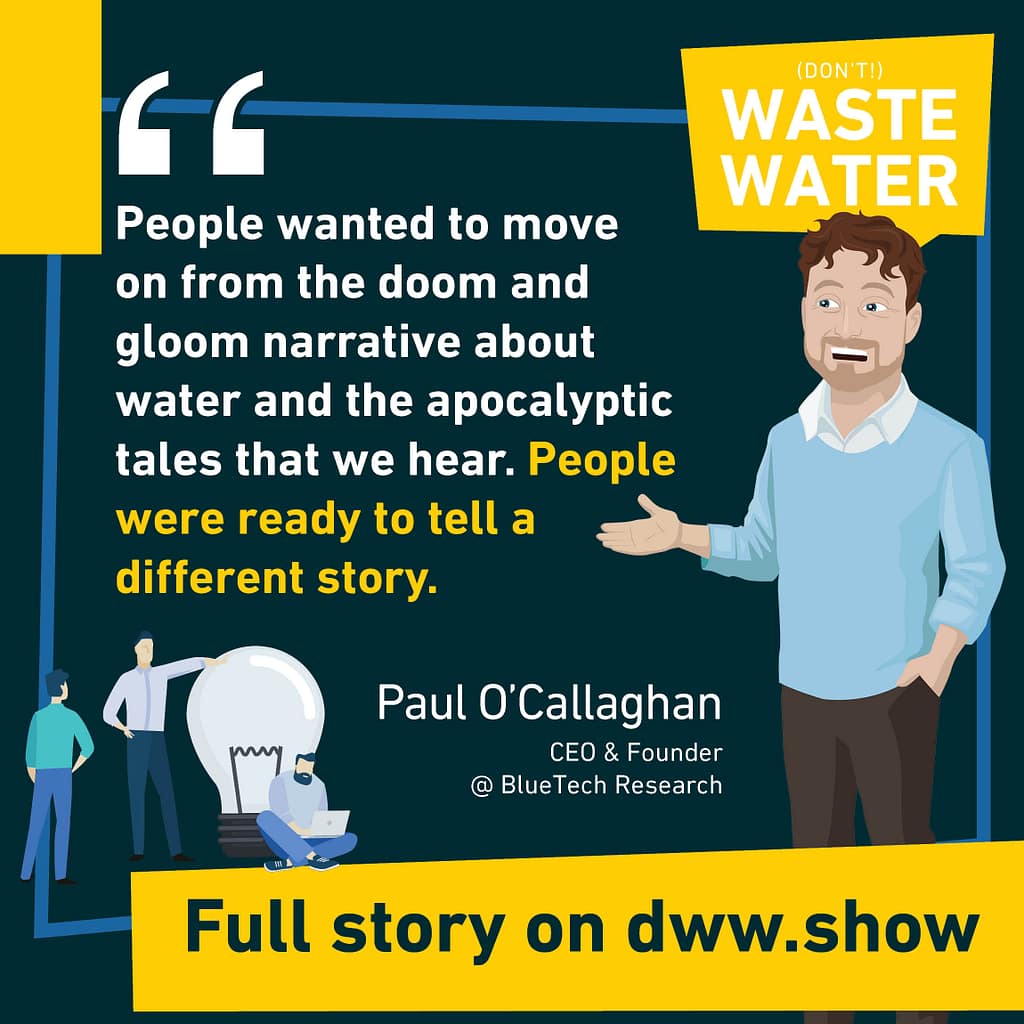
Antoine Walter:
Well, actually the positive story aspect is something very, very important. I mean, that’s the reason why I watched it with my daughter because you know, now I’m talking about myself, but some years ago I brought my sister at the time to the movie and it was like a documentary about planet earth something. And the first image is a, you know, a polar beer. And the first thing that the voice over is saying is, you know, that polar beer is going to die. And it’s like, no, no, wait, wait, I have to explain you. It’s a documentary. All good. Everything. What I loved about brave blue world is it’s not about that. It’s not ignoring the problem. It’s saying, yeah, there is a problem staging the problem. But the problem is in the first five minutes of the movie, and then it’s about the solutions. And that is just, I mean, thanks a lot for that. It’s bringing the positive, really positive light on that challenging topic. So yeah, as I said, I could spend two hours on brave blue world, but in all of that, you still managed to pack in something that people never achieve in a lifetime. You were making a PhD. How in the world do you manage to pack that into your agenda. Well,
Paul O’Callaghan:
You know, everything helps everything else, I guess. I mean, the first of all, the PhD was building on the 10 years of research of BlueTech. So we had a lot of information, a lot of data. I had really good collaborators, both in BlueTech and also in my promoter professor Kay spokesman from wet SIS Lakshmi Adapa, who is a core author on many of the papers that collaborative field. And there were times when I also got tremendous support from people within the water industry, founders of companies like Zenon, Trojan, UV people like Hank Vander, 900 Benedick James at Barnard. And at times it felt like people were willing it into existence. There was, again, it was, people wanted to understand this process. They wanted to know how long does it take, what are the key things that help the technology move along? So a lot of these projects, you find that they’re, they’re not about me so much as they’re about bringing people together with a common goal. But yeah, there were many Saturday mornings when I’d leave, I’d get up early and I tend to offer a cup of coffee. I’m in a cafe nearby and I’d worked for maybe two or three hours on the PhD and then I’d come back and it kinda came together. It took time. It happened over four years. So it wasn’t overnight.
The Dynamics of Water Innovation – Paul’s Ph.D. Thesis
Antoine Walter:
When you, you mentioned BlueTech that, that helps you, that brings data into your PhD. And actually your PhD opens with this staggering statistics of this 9% of innovation across a 300 sample, 9% of innovation in the water sector that make it through, I mean, all the stages and that come to life, which is a positive way to look at it. And now if you look at the negative way, that means 91% of innovation is just, just die. And before focusing into the water sector, is that any different from innovation in general, is the water sector like a special beast or is it really normal to see this 91% of clutter?
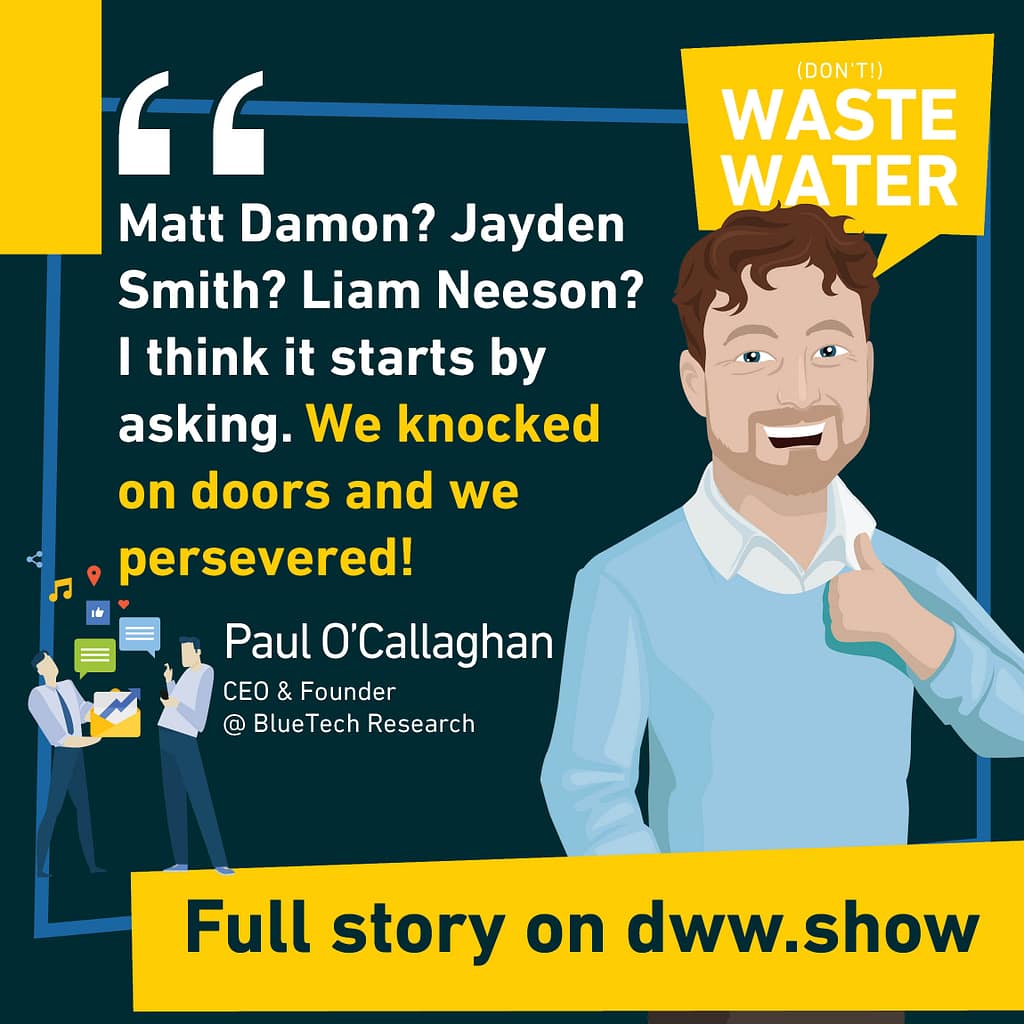
Paul O’Callaghan:
Somehow, the venture capital investment community would typically anticipate that 10% of their companies might, might make it, they might succeed. So the success rate is relatively in keeping with that trend. The surprising thing about the water sector is the number that they don’t disappear or fail, and they don’t really make it. They kind of live in this kind of no man’s land, this gray area, gray zone, where they’re neither very successful and yet they kind of hang on for a decade or two decades. So that’s probably what’s most unique. I think about the water sector compared to other industries.
Is Venture Capital compatible with Water Innovation?
Antoine Walter:
But if we compare it to, to other industries, I mean, in the venture capitalist word, when one company succeeds, it makes a Uber or a Netflix or something really, really incredibly big. And, you know, I had Kimberly Baker on, on that microphone from the elemental excelerator. And what she was sharing is that, yes, they didn’t have this absolutely big company out of the accelerator, but still 90% of those companies survived. So if I get it right with what you’re saying, which makes this big difference, it’s that in the water sector, you don’t have spectacular successes, but still you have a lot of these in-between where you don’t know if it’s a success of failure. It’s a gray zone.
Paul O’Callaghan:
That was one of the things that surprised me actually, was that when we tried to quantify the level of impact, that level of success, no company became a unicorn. There were certain technologies that became what you could call it, a unicorn market where the market reached a billion dollars, but some companies that would be deemed to be successful in terms of the approving, the technology that demonstrated they’ve scaled it up, they don’t achieve that level one impact. They don’t create unicorn markets. So that was surprising actually as a finding for me even. Yeah, I think it’s a combination of, it’s a very diverse sector. It’s made up of hundreds of thousands of different plants all over the world, different sizes and scales. And one of the ideas that we brought to bear and the thesis is that it’s a bit like genetic diversity. It gets one of the positives about COVID-19 I guess, or anything like that is that we’re resilient because we have diversity in our population. Water can be resilient to change because of that fragmented nature of it’s almost like a buffer against disruption.
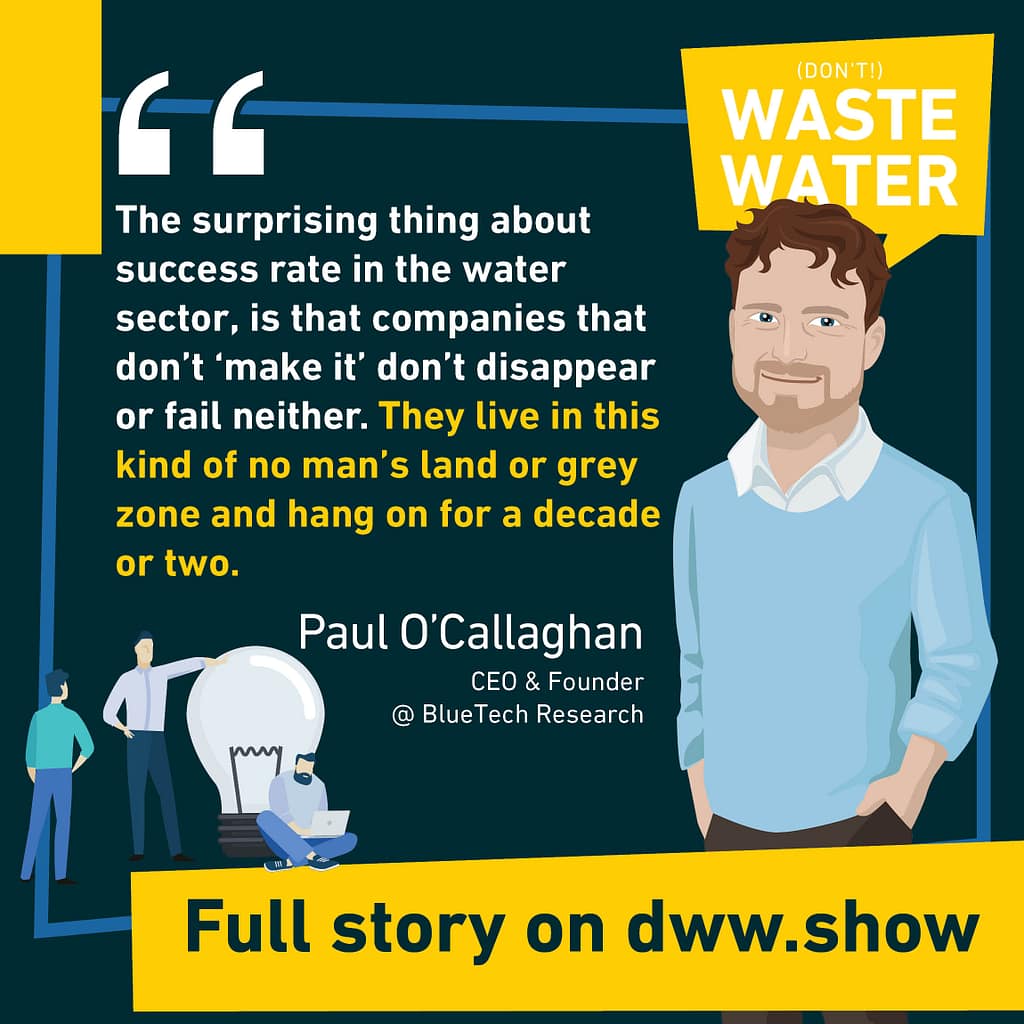
Antoine Walter:
So you mean that the, the water ecosystem of companies is looking exactly like the water itself. It is incredibly fragmented. So you don’t have this Uber or Coca-Cola of water, but that makes it also incredibly resilient in the age of COVID. We experienced that.
Paul O’Callaghan:
Yes, and we have been a very resilient sector throughout this last year or two now.
Water Innovation and R&D Funding
Antoine Walter:
Well, another thing that, that was really striking for me, even if I’m in that water sector now for almost a decade, is that your study is recalling that there’s 35% of the water companies in the Netherlands, which invest into R&D. I was just thinking that was a given that everybody would be just investing in R and D, but apparently not. And you’re also making this comparison between the big companies, their turnover and what they invest actually in water. And it’s a very low percentage. I had a couple of ones. I mean, you also explain why it’s a low percentage, so it’s not really to blame them, but just to put that in context, you’re saying that SUEZ is spending around 0.4% of their turnover in R&D for Xylem it’s 4%, for Evoqua it’s 1.5% for Kurita it’s 2.3%
Antoine Walter:
And, you know, I recalled my SUEZ years where I was working for a subsidiary of Suez and our CEO at the time Eric Dehouck was targeting 8%. He said he wanted to invest 8%. That never happened. What I’m wondering when I see all those numbers is what shall we understand there is the, is it that there is no, no investment or not sufficient investment into R&D? Or is it because the ROI of R&D is not sufficient, that it doesn’t make sense for those big groups to invest heavily in R&D? Well, you
Paul O’Callaghan:
Know, the figures you’re correct. Antwan would vary between, you know, two, three, 4%. It’s that type of number. Generally speaking, we’ve heard that from other companies subsequently after we publish this in conversations, other companies would say, yeah, that’s, that’s, that’s exactly where we are as well. So it seems very consistent. I don’t think the number itself is a major issue or something that we need to be concerned about. I think it’s an acceptable level of investment for a very large firm, such as Suez. For example, the bit that we might want to be concerned about, the message we might want to focus on is how much of that 2-4% results in growth to the business or a competitive advantage or value creation, because that’s, what’s going to sustain that. And if companies see that return on 2-4%, well, then they might say, whoa, why don’t we invest 5 or 6% or 7 or 8%?
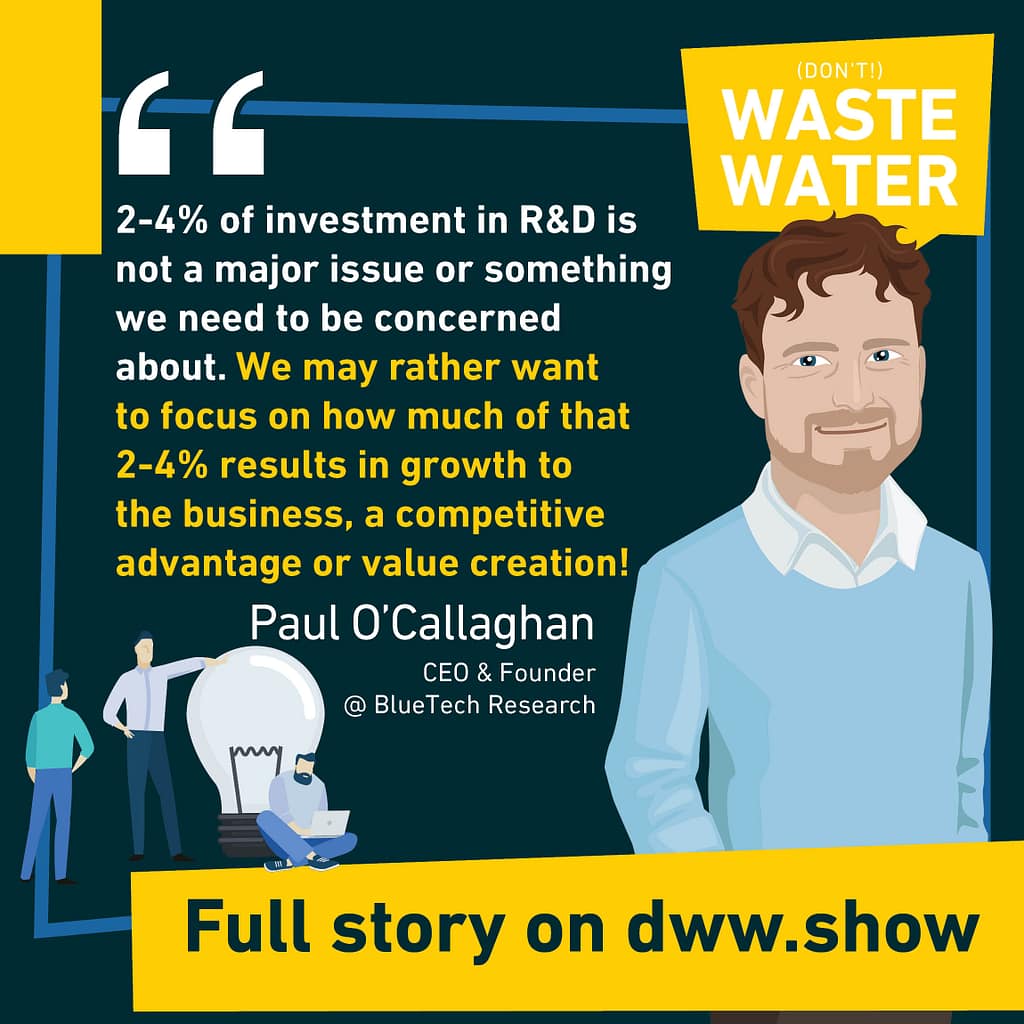
Paul O’Callaghan:
And it’s that rate of success. And it’s where the innovation is focused. So, you know, existing, larger firms are quite good at continued improvement. That’s often called sustaining innovation. It takes what we have, and it makes it a little bit better, a little bit like the way an automobile or a car becomes a little bit more fuel efficient, you know, every year compared to the ones that we drove in the 1970s or so then another how you remember anyway, in the 1980s you wouldn’t, but to the ones that we have today. And I think there’s other types of innovation, which is radical, you know, it’s, it’s completely new and we need to invest in that as well. So it’s all about what type of innovation are you investing in? What type of research are you doing? And trying to really make sure that, you know, the people in the R&D center, that when they go to their corporate managers and they report on the results that everyone is happy and pleased, and there’s no surprises. So if it’s going to take seven or eight years, well, then it’s better that everyone understands that it’s going to take seven or eight years.
“Disruptive Innovation” is an overused buzzword
Antoine Walter:
Your distinction is very interesting because in your paper, you, you discuss how the word disrupting is overused. And and I, I mentioned I mean, I noticed here that you, you say you’re radical, which is a bit more precise due to what it is. What you’re saying here is that if we see the innovation, like, like a funnel where we feed all this innovation at the top and it bubbles down, we said with the first statistics that 91% of the innovation would stay somewhere in the funnel. But if you work on the bottleneck and if you increase the conversion, more innovation is going to make impact, which is in turn, going to push companies to be a bit more risky and risk taking and investing into, into that funnel. Because the ROI again is going to be a bit better to understand your right here?
Paul O’Callaghan:
Yes, look anything that makes this process more efficient is good. And we begin by thinking that we want to innovate, but then we need to figure out what we really mean. Do we want to make something that’s there better? Do we want to solve an unmet need? Do we want to solve a problem? That’s not even solved today. Right? How will you, do you provide water to people who only earn $8 a day? How can you do that for 10% of their income? I believe it’s possible. I just believe that it hasn’t been figured out just yet, or at least if it has, it’s been figured out in some parts of the world, but it hasn’t been scaled up yet. And if we really try and understand at the early stages, what types of technologies we’re working on, then we can work out the best strategy.
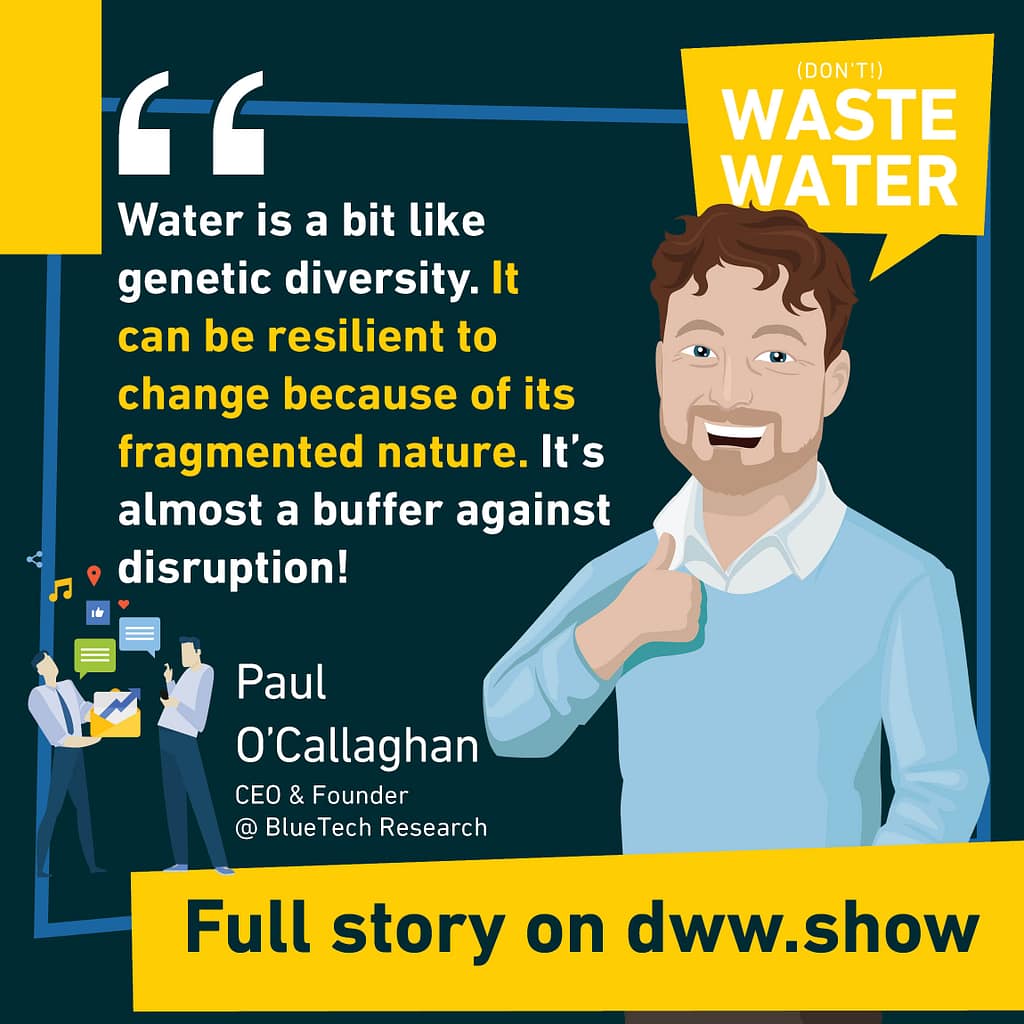
Paul O’Callaghan:
It’s a little bit like saying I want to get a gold medal in the Olympics. Okay. So I want innovation succeed is like, I want to get a gold medal in the Olympics, but what event are you in the rowing event? Are you in the high jump event? Are you in the marathon? Because depending on what events you want to go for, you might want to train for endurance. You might need certain skill sets. And I think if we break it down and say, I am investing in radical functionality, I need a crisis driven innovation. That’s going to require radical functionality. And I need very good leadership as well. Or another firm might say, my innovation is discontinuous. It’s like an electric car. It is a completely different value chain. I’m going to go for ceramic membranes, not polymeric membranes. This is discontinuous. So then you need a different factory, different manufacturing process, different technical standards. And, and you don’t need a crisis necessarily as long as you’re able to be a value-driven innovation. So just understanding that a bit better at the very start allows you to put the right team in place and have the right strategy in place and the right understanding of your risk profile and your timeline.
Value-Driven Vs. Crisis-Driven Water Innovation
Antoine Walter:
You mentioning though, two different terms, this value driven innovation and this crisis or need driven. And was you show in your research is that there is one of these two types, which is incredibly more efficient, which drives much better results and it’s the Crisis or Need driven. Why is that?
Paul O’Callaghan:
Yes, you’re correct Antoine! My God, you could almost defend my thesis for me with the sounds of it. It moves at literally half the speed that the value driven innovation does through the adoption cycle. It can half the timeline. And we saw that very clearly with the adoption of ultrafiltration membranes in the early 1990s, the outbreak of cryptosporidium in places like Milwaukee and the UK drove rapid regulation of the need to deal with cryptosporidium. And that drove rapid adoption of ultrafiltration membranes and drinking water treatment. If you hadn’t had that cryptosporidium outbreak in 1987 in Milwaukee, you would not have seen that level of uptake. And we see similar things with, for example, PFAS at the moment, if PFAS get regulated that will become, you could call it a crisis driven market or in these driven market could be water scarcity, where people are suffering from droughts, and that creates a need.
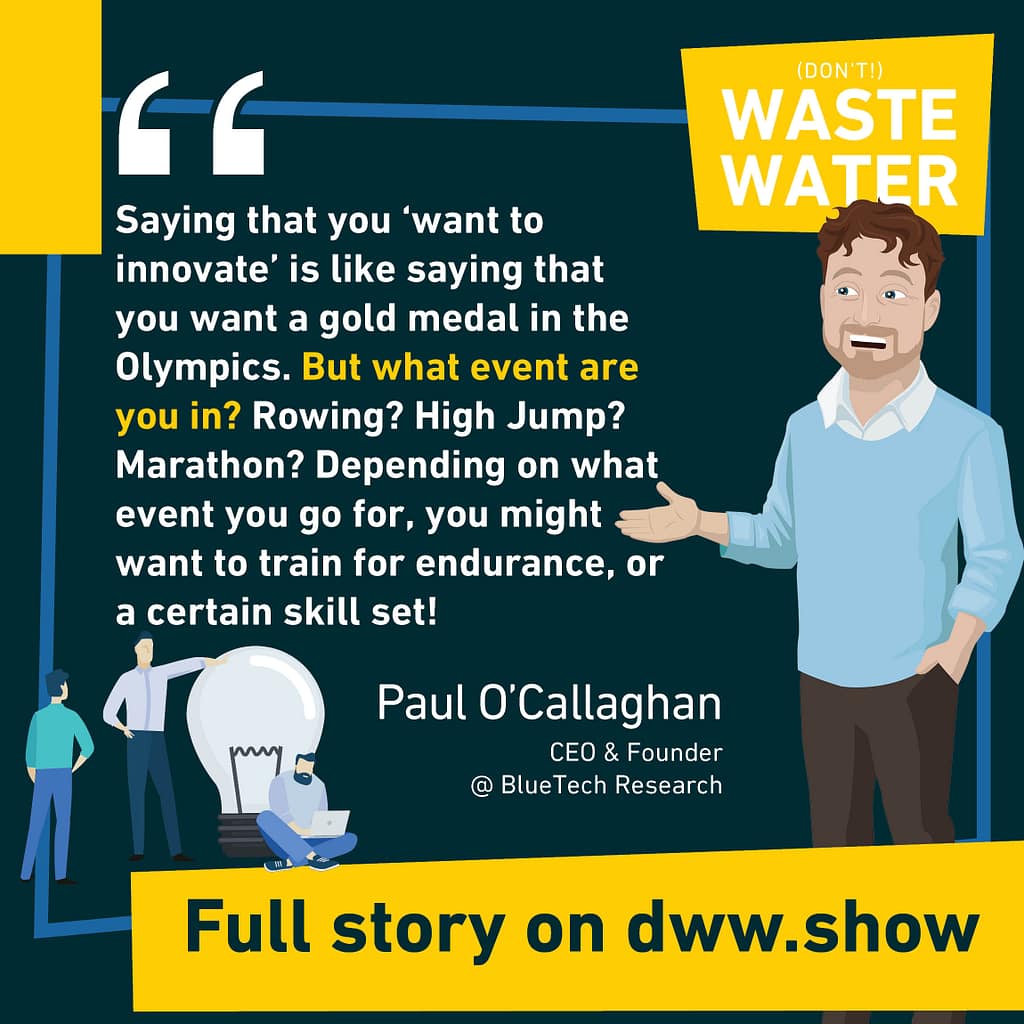
Paul O’Callaghan:
And that accelerates things like a war does it accelerates adoption. Now it’s a bit more risky because you need to make sure that there is a crisis, right? That there is regulation. And we’ve seen people who think there’s a crisis that end up waiting and waiting and waiting. And then the crisis never comes. People who think that, you know, they can create, you know, that sludge won’t be applied to land or that ballast water treatment would be regulated quickly. And of course it was delayed. And so that’s why those things move quicker, but you have to be certain that the conditions are right.
Antoine Walter:
It’s very interesting because, you know, it’s provides me some, some memories, you know at the times I was with Suez, we were heavily betting on that, ballast water treatments. And when I saw that example in, in your paper, I was like, Hey, I know that story, actually, what you shared about the ultrafiltration and cryptosporidium was told us on that microphone by Graeme Pearce, who was also one of your interview is in your, in your paper. And that advise me in the conclusion of our discussion today to invite you on that microphone. So for the ones that’s want the full length story, just check the episode that I did with Graham. I’m going to put the link in there in the notes of that episode.
Paul O’Callaghan:
I would totally recommend that too!
WaTA – Understanding how Water Innovations get accepted
Antoine Walter:
You mentioned this adoption as being something, which is something we should look at, because if we understand the adoption curve, well probably we can understand innovation, and you also even say, we might be able to predict what is going to stick and what is not going to stick. And you have a very interesting concept, which is this, this WATA, water technology adoption, and that has several phases. And it’s kind of your personal take at this curve from, from Moore about the, this crossing, the chasm. Can you take us through the steps? Just that we, we are all on the same page when it comes to this water technology adoption?
Paul O’Callaghan:
Sure, so like this model is used in all sorts of different areas and has been for a long time. You can think about people who use technologies as the innovators, which are not 2.5% of the market would be innovators. They want to try these things very, very early on, even if it’s not perfect. And then we have the early adopters, they come after the innovators, and that represents about 13.5% of the tool to market. And these are folks that when they’re interested, they’re usually quite innovative. They like trying and learning about new things, but it’s got to be proven to some extent. And then you move into the early and late majority. And that’s where the not 68% of the market would lie in the water sector, typically for us to get our technologies into the innovator section. And I think of when I graduated from my master’s degree in 1996, 97, the membrane bioreactor was at that stage.
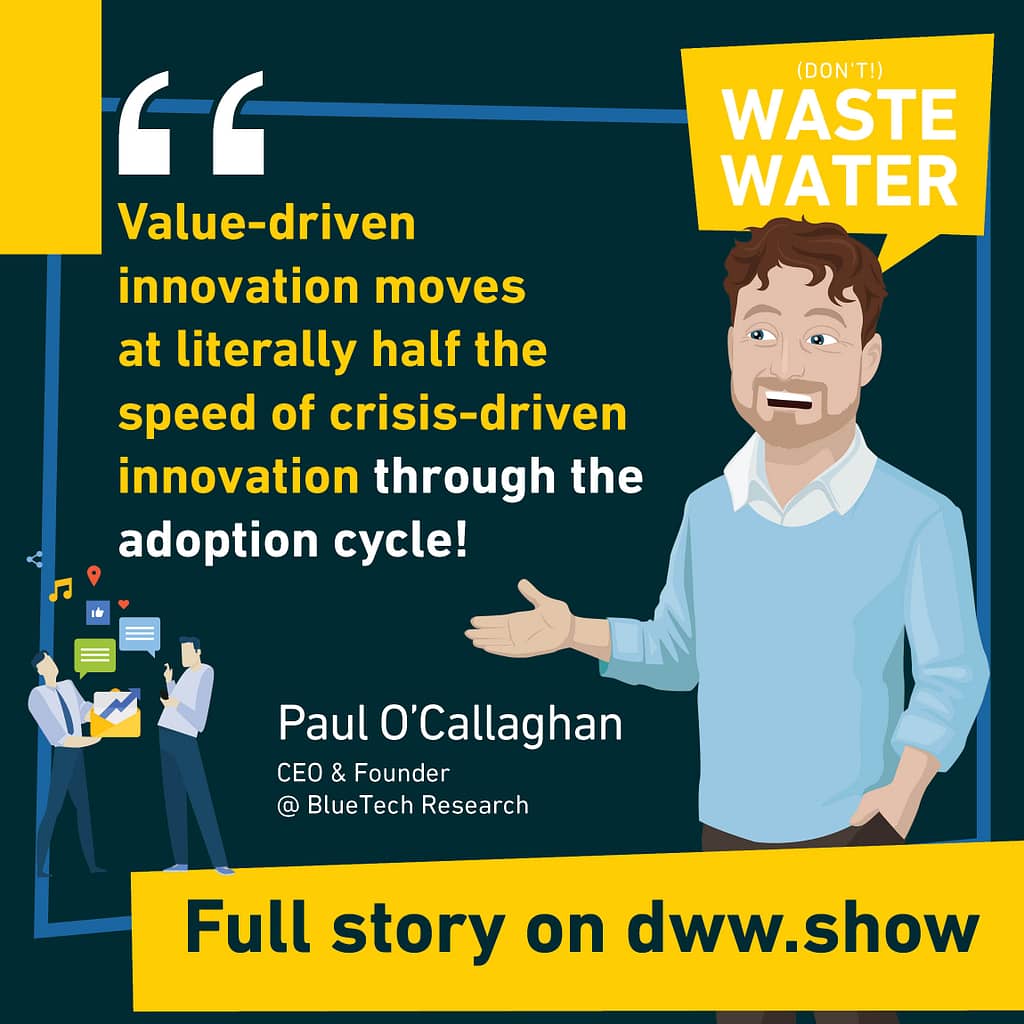
Paul O’Callaghan:
Okay. So it was being piloted and it was being demonstrated at full scale. I actually ran one for Pfizer pharmaceuticals. It was a Zenon and Kubota head-to-head race to MBRs. And only one would make it in that instance, I think it was Zenon that made it, but the point was it was in the innovator section. And that can take about five to eight years. So by the time you’ve completed all of your pilot testing and gotten maybe three full scale demonstration facilities up and running, that can take five to eight years. Typically that gives you a sense for that. And then when you move through the early adopters, these are the people that are going to buy the first 25 or 30 of your reference plants. So this is, it’s not yet called for an, a tender document. It’s not being specified by consulting engineers.
Paul O’Callaghan:
There are probably only two or three companies that maybe even offering the technology that can take another six to eight years for it to move through that section. And then after that period of time has passed, no you’re into the early and or the early majority and the late majority. And you can stay in that sector for that segment for about 12 to 16 years. So that gives you a sense that it moves at a certain pace. And when you’re very busy with your piloting, and you’re testing that to take a certain amount of time, then you’re setting the first units. That’s another period of time. And then after that, you’re in this section where, oh, people are actually calling for this, it’s becoming, it’s at trade shows, it’s a conferences. It becomes easier.
It takes 30-40 Years for a Water Innovation to get adopted
Antoine Walter:
So that full process. If we put that in perspective means 30, 40 years for the adoption, the adoption of technology.
Paul O’Callaghan:
Well, it’s entirely cycle, but from the point where you take an idea out of a Laboratory and you begin your first pilot to the point where it now is right in the middle of the market, there were, you know, a hundred or more plants out there. And the market’s going really rapidly. That whole timeframe that can take about 12 to 16 years. So if you’re a startup company today in 2021, and you just did your first pilot, you would expect that maybe in 12 to 16 years time, this would be a mainstream market opportunity. That’s growing very, very rapidly. And it might move a little bit faster if it’s a crisis driven or a needs driven market, but those are the average timelines.
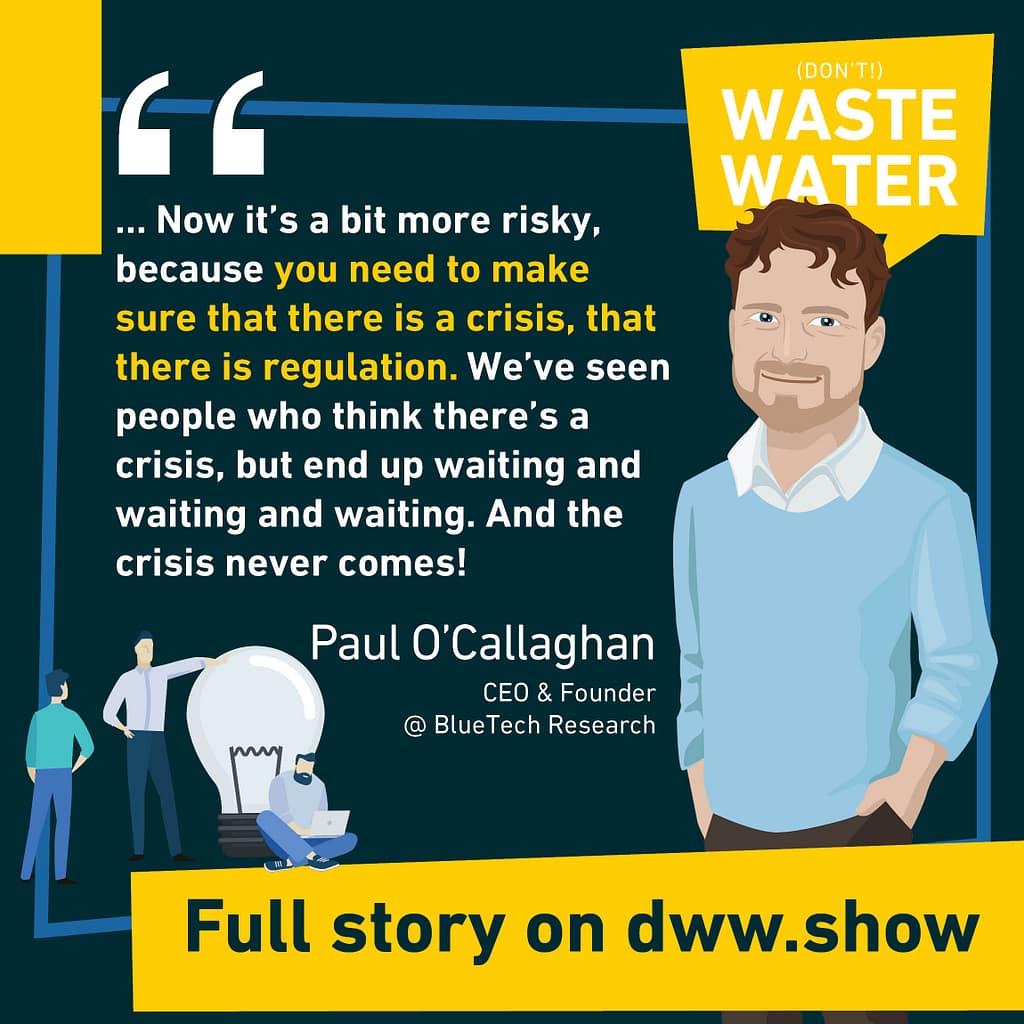
Antoine Walter:
So you were saying that basically in the water sector, it’s not possible to see a, like an iPhone. It comes on the market and by iPhone three, it is almost adopted by everyone, not as the iPhone itself, but as a smartphone where I’m heading here is that, you know, I think it was very reassuring to me to read that in your paper, because I recall when I was working on pilots and I was frustrated as a young professional to see that the pilot was successful and still the markets wouldn’t just take it and build it everywhere. And it wasn’t understanding that, you know, it was like, come on, it’s now six months, six months as we prove it’s working. And what you were saying is that what you’re looking at is a timeline of 10, eight years, six years, if it’s incredibly successful in an answering to crisis, but still not six months.
Paul O’Callaghan:
Exactly. Yeah. And I think one of the strongest bits of feedback that I’ve had from people who read the thesis is, well, this is for the first time we can know, you know, go in front of the company and, you know, the, the management team in our company. And we can say, Hey, look, this isn’t just us. This is objectively based on a lot of data over a long period of time. This is quite typical. And yes, there are ways you can have the time sometimes. And there are certain strategies that work in certain cases, but there are other limiting factors like the procurement cycle. It takes quite a while to tender a job and to procure a job, to construct a project itself that can take quite a bit of time in terms of design phase building. So it allows us to be more real, but you’re correct. The iPhone, you don’t see things like the iPhone. Although I think even the, iPhone probably was being developed for quite a period of time before we sell it in the shops. You know,
A dense jungle of Water Innovations
Antoine Walter:
Maybe you as, as BlueTech, you have a view of what’s happening in these very early stages, but us, the usual, what a professionals, we don’t know these early stages. So we see something when actually it is crossing this chasm. So maybe we see then timelines, which are not as real as they really are. And what struck me as well in your paper is that when I had this discussion with Graham, he was telling me the story of, of MBRs and how it was quite hard to bring them on the market and how Zenon was the lone ranger fighting in the desert. And when I was preparing, you know the, the sentences of that discussion, I was reading some older papers and it was really struck to see that MBRs were commercial long before they came into, into the books. And I was thinking that must be an exception. It cannot be. I mean, if something is commercial and out there, for sure it’s in the book. And when I read in your thesis that no, actually the university papers and the, and the official books are the laggards. They always come last. How’s that even possible?
Paul O’Callaghan:
Well, similarly to you. I have met caffeinated on the shows behind me here, which is your classic design engineering manual. A part of it is down to the fact that technology development is a race. It’s a race against funding running out against patents, expiring against competition, entering the market. And it’s a race against commoditization. So when an MBR was first developed, there are only a few companies that had the know-how, the expertise, the secrets, to know how to do that. And they had proprietary technologies, which were controlled and patented. Nowadays, you know, pretty much anybody with the right designing expertise could design an MBR. You can purchase the membranes and you can design an MBR. So when it gets the point, when the knowledge is so widely spread, and the art is well known within the engineering community, at that point, the race is over. The technology, race needs, innovators, entrepreneurs, typically who build companies around being able to be the only people or a few people who can offer that technology.
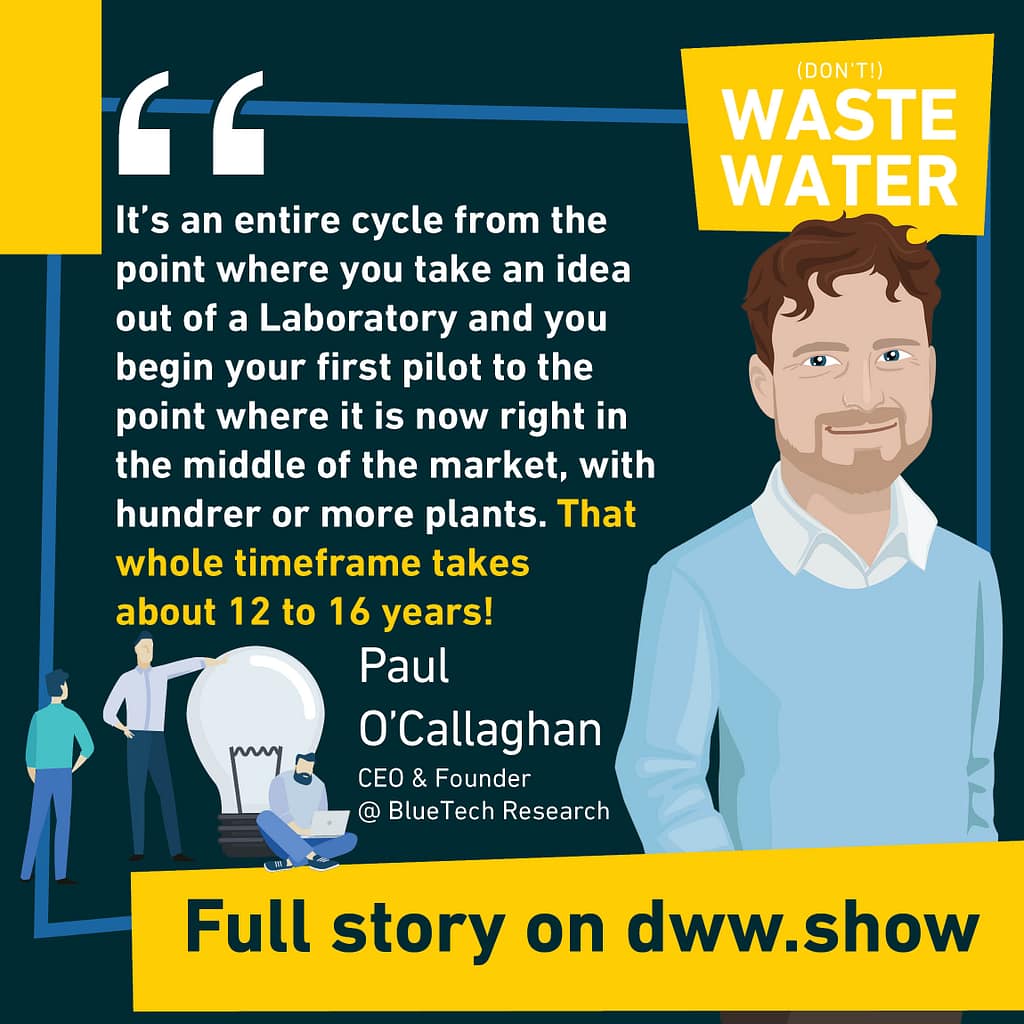
Paul O’Callaghan:
And eventually it becomes more and more mainstream. So even with the iPhone, you can buy a smartphone nowadays from so many different people, but there was a period of time when the rural, you smaller number of companies that provided a smartphone with, you know, with touch screen phone. And that’s the reason why it takes time to get into the engineering books. And a great example at the moment would be Nereda is a proprietary, granular activated sludge technology. And there are only a handful of other companies out there, like indents that provide granular sludge technologies. So for know how to do that, how to control the process is not widely known. It is being decoded and engineering firms, for example, Black and Veatch, and others are doing a fantastic job of helping to understand the principles. But I think it’s natural and will be expected that, that the textbook in many ways, by the time it gets into the textbook, the companies who are going to really make it big, probably already have made it bigger or as they failed.
Universities, Schools and Books are laggards when it comes to Water Innovation
Antoine Walter:
It makes a lot of sense when explained in that way. I still believe that’s a bit sad. You know, you’re, you have this new generation of people that are trained to a technology, which is not the technology of today, which is the technology of yesterday. And when I say yesterday, it’s a decade ago or 15 years ago, which might be a problem because you’re also showing that when people understand the innovation, it gets much faster for it to be adopted. And I was reading a good example of that in the book. I can’t remember the author, but they won the Nobel prize for nudge. They were explaining that when you are choosing your, your ice cream flavor, you can have a choice between 10 or 15 different flavors. It doesn’t matter because you know, all of the flavors. So you’re able to make a good choice.
Antoine Walter:
But if you are confronted to even just two choices and you don’t understand whether the one nor the other, well, you can only make a bad choice because you don’t have all the information. So if you don’t have the right information, you cannot make the right choice. You stay with the inertia with the status quo, and you don’t go for the risky one for the innovation. One is like a double problem. On one end, we don’t teach innovation at the right pace so that the new guys that come bring some fresh blood and some fresh ideas to the market. And on the other end, we know that there’s this silver wave of people very experienced, which are leaving that market. So shouldn’t that make us pessimistic about the future – I’m really playing the devil’s advocate because I know you’re the, the positive guy.
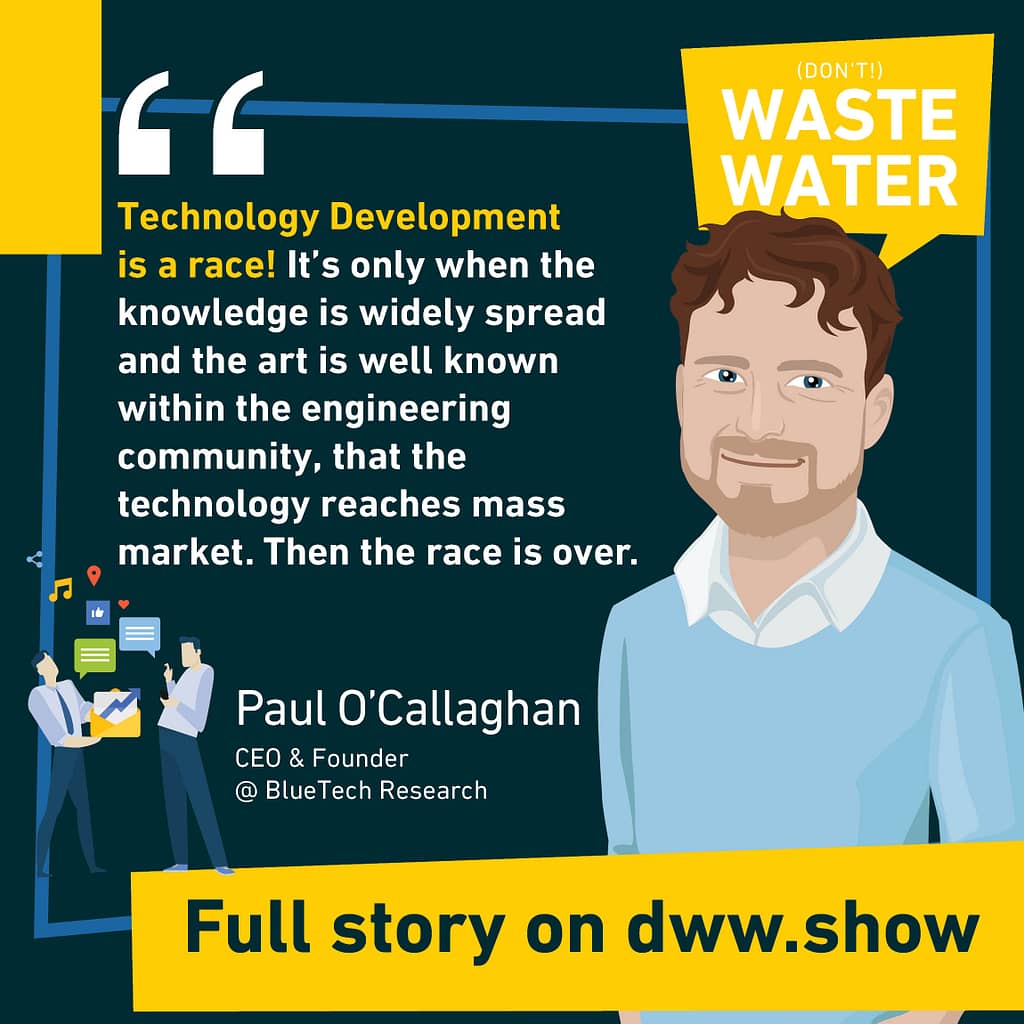
Paul O’Callaghan:
Well, look, I think the next generation of water professions and already, we all know that it’s about continual learning now. We all know that our knowledge is outdated so fast, these days, that once we leave university, it’s not like ‘that’s it’. And therefore it’s the skills you learn about biotechnology, about material science, about fluid dynamics, about engineering, whatever those principles are, you apply them to try, to understand these newer technologies. And the peer reviewed literature is fantastic because it keeps you current even more current. Again, our IDB, our papers that are presented at conferences, which we at BlueTech would go to quite a lot, because that’s where you get the real up-to-date knowledge. So if you go to something like Singapore water week or WEFTEC or something like this, the papers there are the latest. And as long as you can apply critical thoughts based on your science and engineering disciplines, to understand how does this work employee, then you can stay current and you can, you’re never boxed into yesterday’s solutions, as long as you have. We need the science and engineering, but we can apply it to the study of any of these emerging technologies.
The more you understand a Water Technology, the faster you adopt it
Antoine Walter:
Let me take two examples here to try to, to understand that that the first example is the one you just shared about Nereda. I mean, if you understand activated sludge, you understand that what Nereda is is adding to that. So it’s like sustaining innovation to stay with. I mean, very, very interesting and innovative one, but still sustaining innovation. And if I take on the other end, another example, which comes from brave blue world, actually, which is aquaporin. Aquaporin, I listened to one hour of interview of their, their technical director with Abdelhakim El Fadil. And I listened to that interview twice, and I’m not sure I understood it. Then I saw them in Brave Blue World and still I get, I get it, but I don’t really understand it. So I would see, you know, if I was to predict, even if they are both amazing technologies, the uptake of the one shall be much faster than the other. Is that a right way to understand that? Well, I think
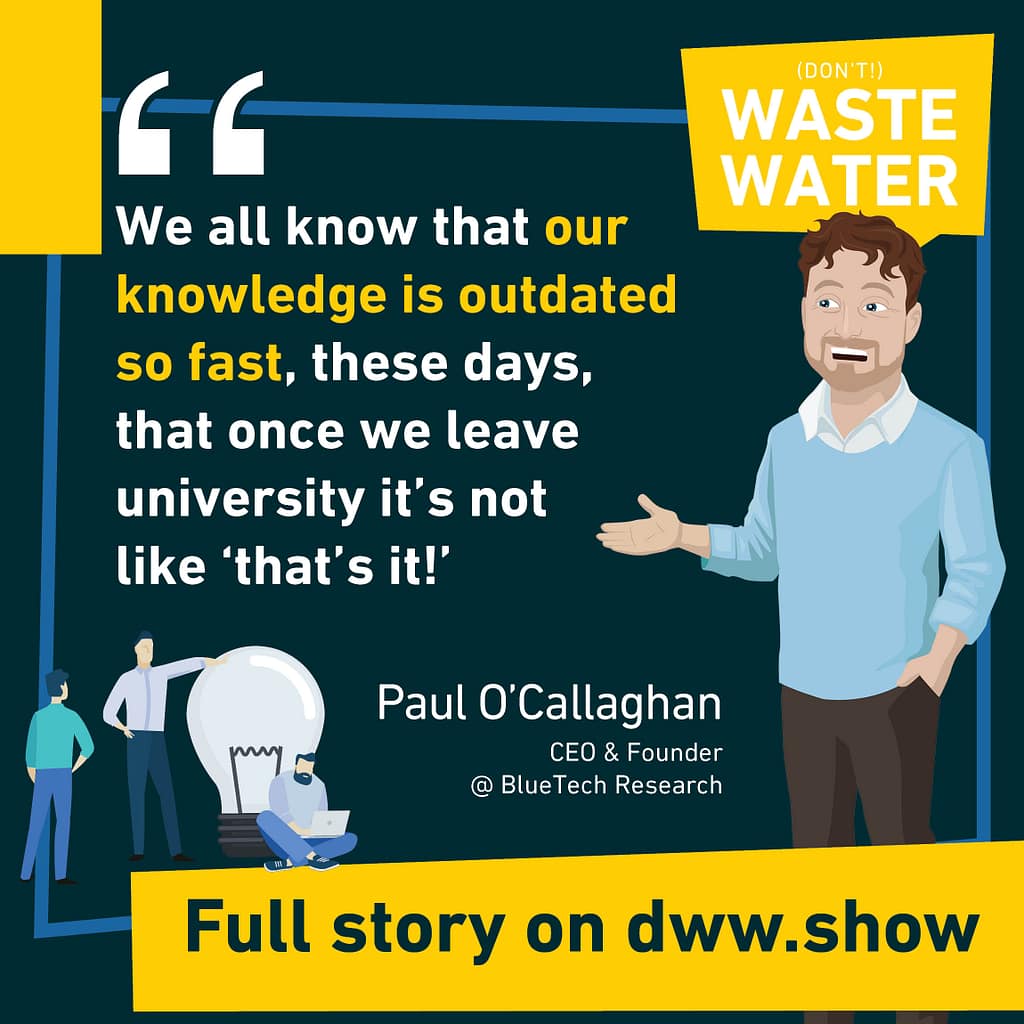
Paul O’Callaghan:
Increasingly the water sector is becoming more multidisciplinary, you know, 30 or 40 years ago, that textbook, that I mentioned was a textbook for people who studied civil and environmental engineering. These days, we don’t just need civil and environmental engineers. We need those plus data scientists, people who have expertise in computer algorithms and sensors and biotechnology, and it’s that cross collaboration of solutions. So within aquaporin, it is very different because it’s taking a protein and trying to stabilize that protein in a membrane that can then function in a different application, could be forward osmosis, for example. So you’re correct. Nereda is easier to understand and easier to apply. Things like bio-electrical chemical systems, or even, you know, satellite-based leak detection, things like this are coming from different disciplines, but I think that’s where probably the exciting opportunities are. And indeed I would add business model innovation and financial innovation to that as well.
Innovation in the Water Industry involves rethinking Business Models
Antoine Walter:
It’s interesting because what you share reflects on thoughts that many of my previous guests have shared here. I mean, Gaetane Suzenet made about 15 minutes around how you can innovate on business models and how we shall innovate on business models. And coming back to my discussion with Graham Pearce, I remember him sharing that full story of membranes. And it was like, you know, it’s very surprising to me because back in my Suez years, I was working with Aquasource and Aquasource is like the French membrane by on a year. So maybe not that famous outside of France, but the other way round, this is true as well. When you’re in France, you don’t know that much, that there’s anyone else than Aquasource. Nowadays it’s no longer true, but at the time it was really Aquasource. And it was like, I don’t know that story.
Antoine Walter:
I don’t know this Zenon, Kalsep all of those guys developing membranes because to me the one developing membranes was Aquasource. So, you know, I was just thinking of this snowflake effect. I’m a special snowflake. Everyone is a special snowflake. So it can come with your thing, which is proven with thousands of plants in the UK, come on, it’s not France and France is specific. So it’s not going to work in France. Do you think this kind of village thinking is also something which still comes in the way of innovation in the water sector?
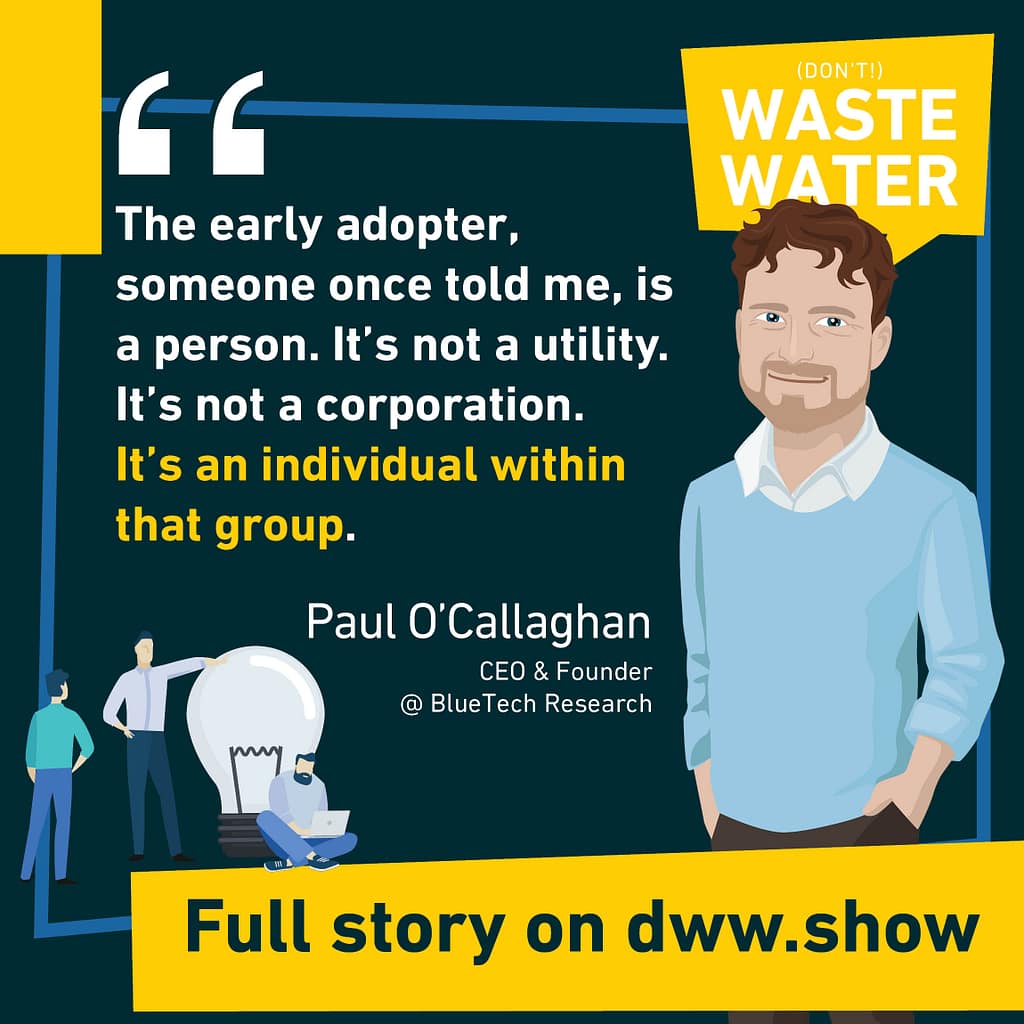
Paul O’Callaghan:
You do see that phenomenon quite a bit where it’s proven, but it’s not proven here. You know, it worked in your bowl, but the wastewater might be different over here. And then you see the same thing playing out in the United States itself, where, you know, it’s working in California, but you know, it might not work in Missouri and it’s going to be piloted there. And, you know, to get around that various things have been tried. They came up with what was called the 10 states standard at one point in time to try and have something that was widely recognized that people could accept environmental technology verification has been tried. There are differences in nuances, in different types of water, drinking, water sources, and wastewater. So there is an element of that. You do need to understand the local context and things do need to be piloted, particularly in the industrial context where industrial applications do tend to be quite diverse, even more so than municipal wastewater, where it might be just temperature and strength to the key variables.
Paul O’Callaghan:
It is an issue. I think, sharing data and allowing people to realize ‘Hey, you know, this has actually happened. And you know, there is like a hundred plants out there already.’ That type of information gives confidence for us collectively to understand that this is a real technology. Now it’s not just being piloted and it’s not a bad thing that it’s been developed in France and separately. We do see that sometimes you get simultaneous development of technologies in Japan, for example, and the same technology might be being developed in the United States. And, and that’s good, but sometimes they only make it in one place and they never make their way out beyond that one application, which is also quite interesting when you see something that is hugely successful in one part of the world, but it doesn’t seem to manage, to break through, into other parts of the world.
Does Water Innovation tick at a particular pace in Japan?
Antoine Walter:
You mentioned Japan and Japan comes back quite a lot in your business because quite often all these technologies seem to have like a first life in Japan. And then one decade later, they go out in the world. And I was wondering, is there anything different in Japan compared to, to other countries? Or is it like, you know, there’s the water world and everything is exactly the same wherever you are.
Paul O’Callaghan:
Japan has a few unique things that characterize it. There’s an emphasis on quality above just about anything else, Japan. I think anyone that knows a little bit about the country and its culture would, would know that. And I think when they looked at ceramic membranes, now there’s a broader story about why ceramic membranes were adopted in Japan. It relates back to a semiconductor manufacturer that they were looking for an alternative outlet for ceramics and water provided one. But the point was they were willing to pay a premium for a superior technology that would last longer. It would outlast polymeric membranes and that willingness to pay the premium for that quality was what drove the rapid adoption of ceramics in Japan. Over time of course, once you can get that adopted the high-end of the market, what you generally, the pattern you see is that manufacturing scales up adoption goes up the expertise. And then hopefully over time you get that reduction in cost and maybe more widespread adoption of the technology.
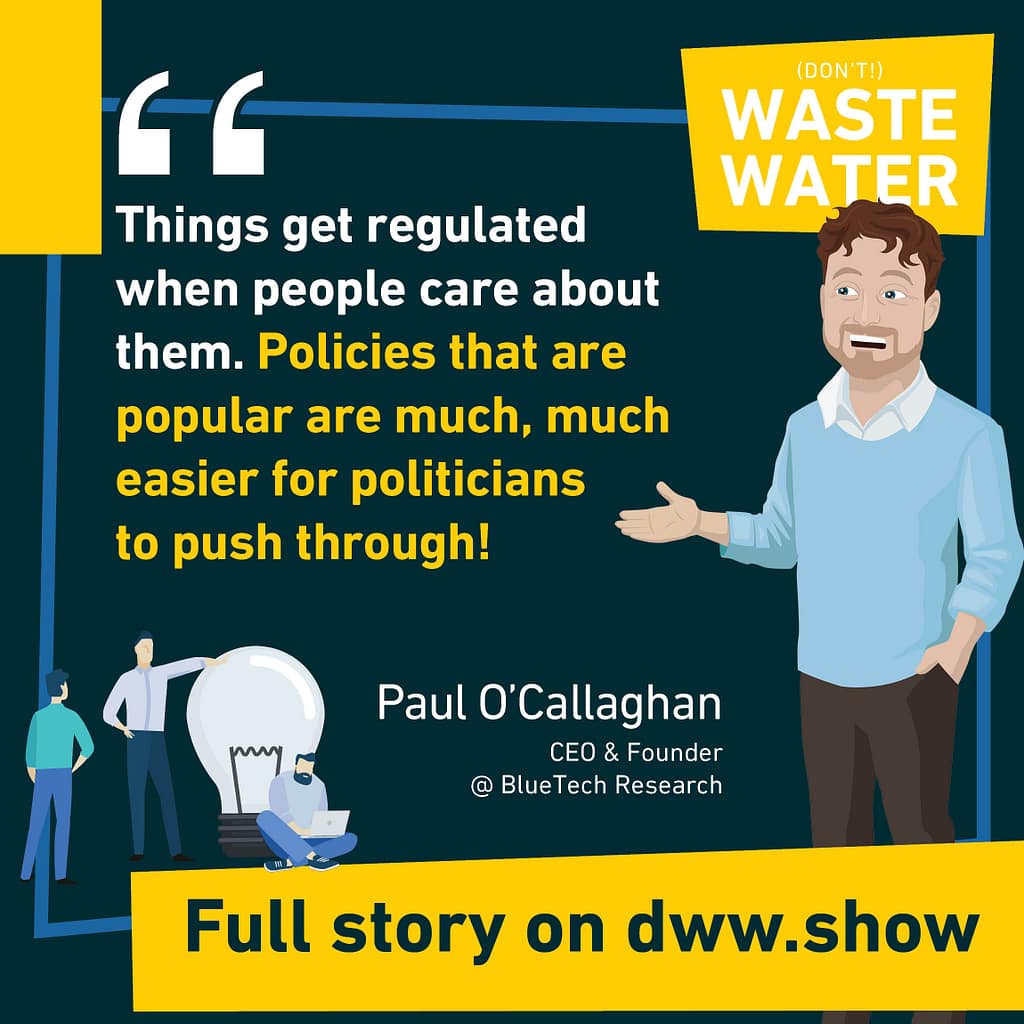
Antoine Walter:
But this Japan dichotomy was especially striking for me because I had interviewed BioCastle, which is an Israeli startup, and they are in encapsulating nature. And it was the first time ever that I crossed this technology. So I wouldn’t say I’m a laggard and probably a water sector average. Let’s say. So I never crossed this technology to meet was new. It was fascinating. And I was really happy to have Ofir Menashe and Gabi Wolkinson on that Microphone explaining all of that. And then I read your cheeses and to see, yeah, that’s something which was around in Japan for like 25 years. It hasn’t made it through a unicorn level yet, but still is making good, slow progress. And I was like, how can it be? It’s like, you know, other ecosystem, which I was totally unaware of. Maybe I’m the one which is not reading sufficiently,uscientific publications, but still, how can you teach the markets about innovation? And is it something that makes sense to even target to teach the full market about it, or shall you really go targeted at some, some special places?
Paul O’Callaghan:
That example with BioCastle is an interesting one. There are companies like Microvi biotechnologies that are still active in that area, lend to cats, check companies. Similarly doing bio encapsulation has subsequently been acquired by another company. That technology area also originated in other areas of cosmetics. For example, medicinal applications. It’s very specific. The know-how is quite specialized as to how to encapsulate these organisms. In that one example, you’re correct though, that for the vast majority of people within the water industry, these are things which are on the fringes. They’re not something that people are going to happen upon day to day regularly, and they don’t need to. These things are for the innovators and the early adopters to begin with. That’s just how this works. And eventually once they’ve proven that technology, when supply costs 11 over plants up and running, then we will see it occurring more widely.
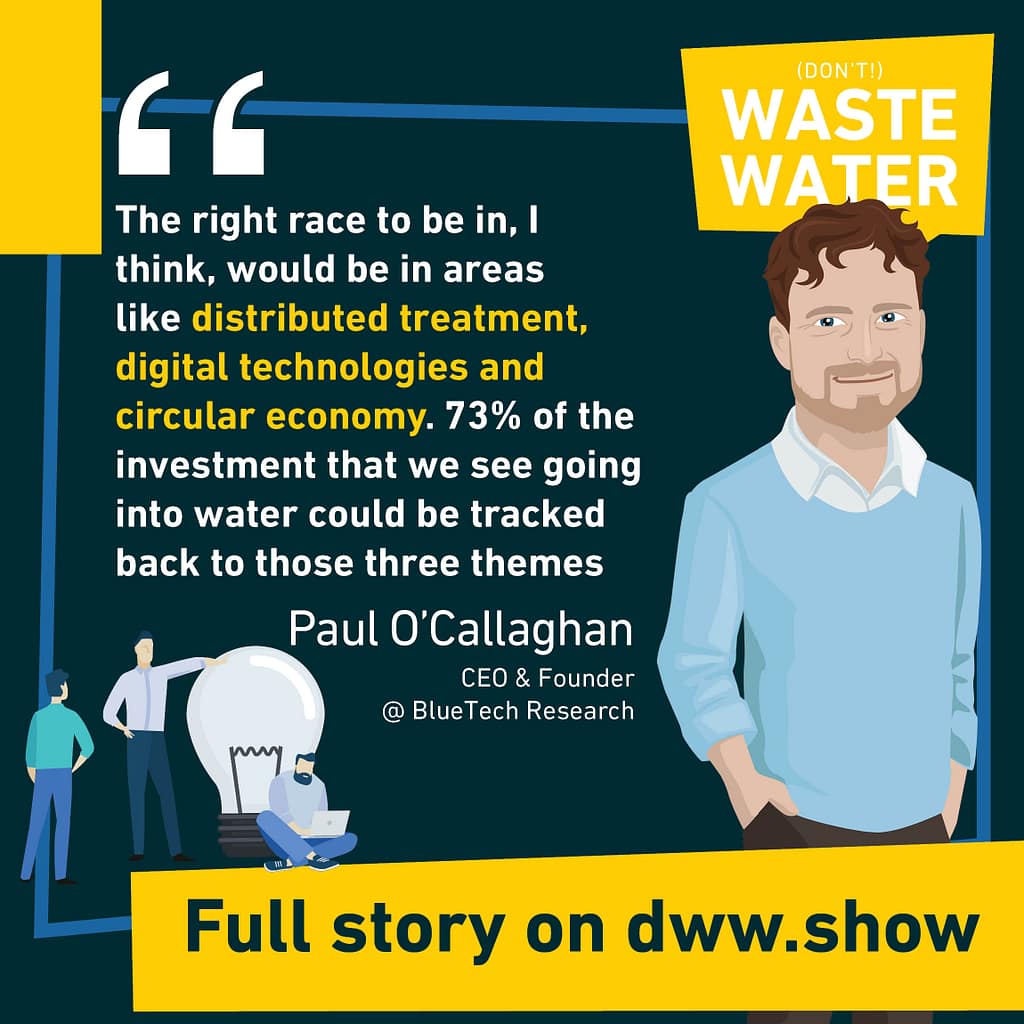
Paul O’Callaghan:
There will be more published papers on it and it would be adopted. So it’s always a small group at the fringes and at the margins that are going to be aware of and looking for these technologies, the job for BioCastle is to find those people, you know, because they need them. They don’t need, you know, a thousand customers right now. They need 10 customers right now. And they also need to figure out what is the most pressing challenge that they can solve with encapsulation? Is it micro pollutant removal? Is it nitrifiers and cold weather when the temperatures are at, or is it stability? What is that thing that they need to solve? So, and then they’ll focus in on a very small percentage and then eventually we’ll all know about it.
How to find early adopters for your Water Innovation?
Antoine Walter:
How do you find those early adopters?
Paul O’Callaghan:
The early adopter, someone once told me, it’s a person. It’s not a utility. It’s not a corporation. It’s an individual within that group. So how do you find them? Well, they’re often the people that are out there speaking and presenting at conferences. They’re there, but you know, that’s, that’s the job and that’s the skill you need to try and find those folks. They are there. They’re always there and then work with them. Cause they’ll be your partners. They become co-collaborators and they’ve come equally important in the first, second and third units that you’re ever going to do deploy.
Antoine Walter:
If I recall the few early adopters I’ve ever met and I’d like to make like a generic portrait of them, they are passionate about what they do. They are in that business for like 30, 40 years. And yes, they’ve published a lot of papers, but what I would see as a threat there is that all the ones I know, and I don’t know that much, but all the ones I know are going to retire in the next decade. So is it like a tropism that, of course, those, those ones are publishing a lot of papers. So you, you, you, you do get them, but once they’re no longer there, a new generation is going to replace them or really is there shifting tectonic plates in the water industry. And those dinosaurs go extinct somehow?
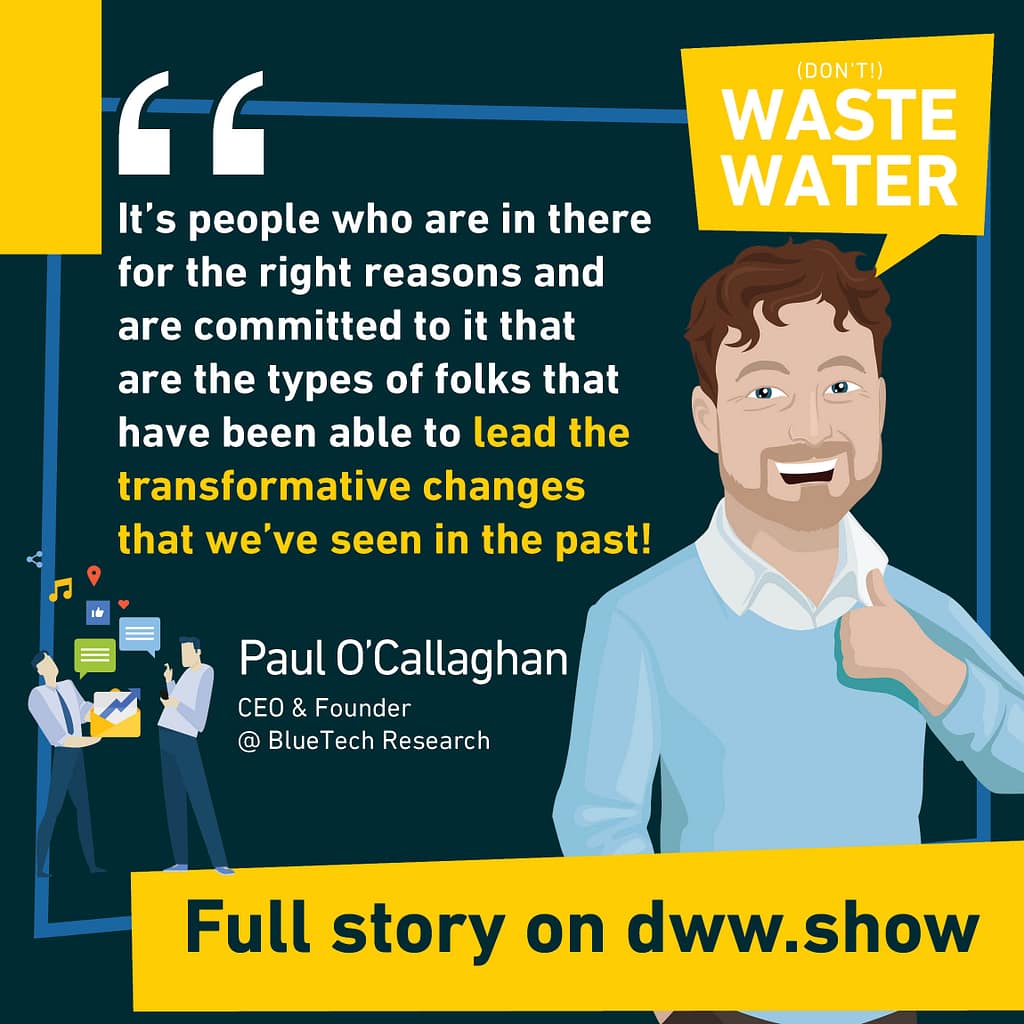
Paul O’Callaghan:
Well, we are losing a lot of institutional knowledge. There’s no doubt about that in the next 10 years. And we’re already seeing it happening. And I love working with those types of people. It’s one of the things that we really value of BlueTech cause we work with people like Graeme Pearce, you will not come across someone that knows more about membranes and that level of expertise, knowledge is not built up overnight. It’s something that it takes quite a while to build up. So we do need to transfer that though one potential change I’ve noticed is when we speak about future scenarios to different groups of water professionals, we gave a presentation one day to water utilities, and we talked about the utility of the future and decentralized distributed models. And the first reaction was, gee, I don’t know, you know, that, that makes me nervous because there could be biofilms on the point of use filter and who’s going to replace the filter and who’s liable for this.
Paul O’Callaghan:
The next morning we gave the same presentation to a group of young professionals and the reaction in the room was quite different. And when we asked the questions, do you have any concerns about maintenance? No. No. That would be a cloud-based system where it could be a service-based business model. You know, a lot of it can be done remotely or it’ll trigger a reaction, which would cause someone to go to that site and replace that we’ll know because of sensors and data. So sometimes the next generation we might find have less limited thinking. So I suppose there’s an opportunity in that. And as long as we understand all the science behind it and the principles and combining that open-mindedness perhaps, perhaps it’s, it’s just different.
Are there shortcuts to Water Technology adoption?
Antoine Walter:
So now let’s, let’s just recap what we’ve learned so far for the wannabe startups out there. If you have a cool product, don’t worry, it’s going to take eight years, 15 years to get it through these early stages. So just keep pushing, it’s going to happen. And you mentioned something about the two types of innovation, the, the value-driven one and the, the needs driven or the crisis driven one and the much more potent one here is the crisis or need driven. And I was wondering when I read that, you know, if I try to optimize everything, you know and I say, okay, there’s this 80 20 rule. 20% of what I do is, is generating 80% of my outcome. So let me just concentrate on that. What are my 80% here by 80% is I need the problem I solve to be regulated. If that happens, then I’m a winner. My technology is going to make it through the market. And I was thinking, you know, why bother developing a product? You have something of a proof of concept start lobbying. And as long as it’s not regulated, don’t pour one single dollar into your innovation. Yeah. Yeah. Well,
Paul O’Callaghan:
Look, that’s a disruptive idea in itself. You know, that idea that perhaps that’s the opportunity is to be the lobbyist, but I think, you know, things get regulated when people care about them, policies that are popular are much, much easier for politicians to push through. The mayor is unlikely to do something that is going to be unpopular with people. So getting people to care about water, getting people to value water is really the starch. And how do you do that? That’s where we hoped to make some effort with the brave blue world, through storytelling and with water. People need to understand that there is value here. There’s value for everybody there’s value for ecosystems or cities, ourselves in terms of our own health. And if we can get people to view it like that, then everything becomes much, much easier
How to tell a compelling story to leapfrog Water Innovation
Antoine Walter:
Facts. Don’t convince people, you have to bring an emotion to bring a story around it. But that brings me to the question. You know, when you look at scientific papers, I certainly didn’t read as much as you, but I read some and all of them tell you, you know, there’s that problem. And we solve it. And technically it’s incredible. And it’s difficult to build a story on that. It’s always much, fact-driven scientifically driven. I had guests on that microphone who were really extreme saying that we really suck at marketing in the water industry. Maybe that’s a bit over the top, but still these elements, you know, marketing is seen as something negative when at the end of the day, telling a good story brings everyone forward. So once we agree on the, on the problem and on the, on what we shall be working on, what is a possible solution to that?
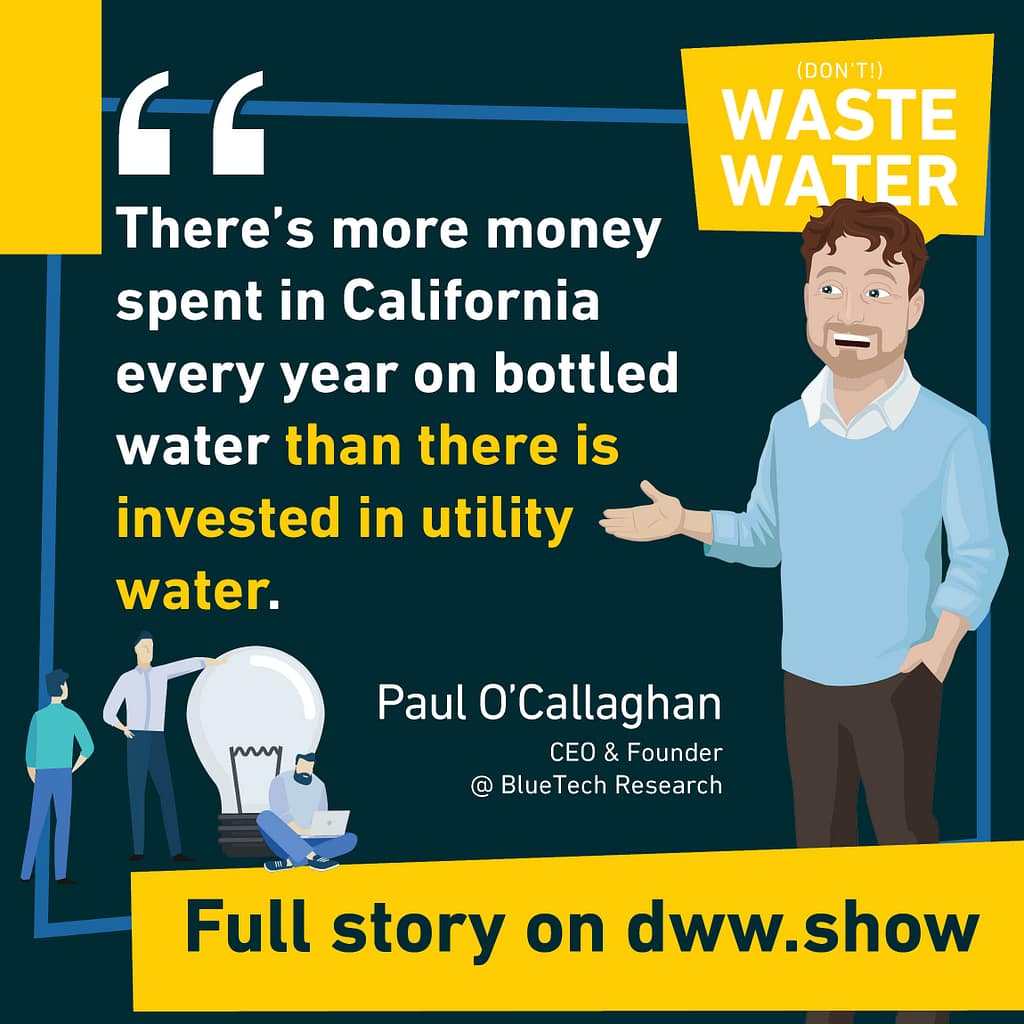
Paul O’Callaghan:
You know, I agree. I think marketing shouldn’t get a bad rap, right? We’re here to serve and we just need to figure out how do we best serve the people that we’re trying to help and what is it we’re doing for them? And if we think of what we’re trying to do for end-users and we work backwards from there, and it’s not about us, it’s not about that particular sensor. That technology is about, this is what the value you’re creating. And you understand that story. And very importantly, you have empathy. You empathize with the people you’re trying to help. And if you do that, then you will be able to market to them. And by that, in some ways that’s simply means change how they think that’s how you change the world. That’s how you win people’s hearts and minds. And that’s what I did notice when I was traveling in places like Singapore or the Netherlands or Israel, when you can get ordinary people to engage with this topic in a way that they Singaporeans know that this is very, very important to their national security. And you can, you can hop in a taxi cab in Singapore and have a conversation about water before too long. And you figure that out because everyone knows an awful lot about it. The same is true in the Netherlands. Same is true in places like Israel. So, you know, we do need to market. I think some countries have done that better than others and some countries it’s been easier for them because it’s just so obvious. You know, that the issues are so obvious.
Reaching the General Public to advance the UN Sustainable Development Goals
Antoine Walter:
There’s a pattern in the three countries you were citing. I mean, Singapore is counting on recycling water to, to cover more than half of, of its needs in the decade to come. I think Israel is recycling 85% of its water. And the Netherlands, if all the countries before on the Rhine river don’t deal correctly with the Rhine river, everything they have to drink is salty water. So when there’s a problem, there’s a high awareness. When I’m just wondering, you know, is if it wasn’t for the UN sustainable development goals who would know out there in the world, if you go in the street that 80% of the world’s waste water is still untreated today. And even today, if you go out with industry, I shall do that experiment one day and ask people how much of the wastewater of the world’s waste water is treated.
Antoine Walter:
How many people don’t have access to drinking water. I mean, that’s the first minute of brave blue word. And if you look, one startup pitch down those days, they all start with that, that figure. But yet I’m pretty sure if you go there and you go to the general population, they just don’t know about it. So is it a chicken and egg problem? If you’ve been dealing with water scarcity for a decade 20 years or forever, if you were in Israel, then you knew about water, but knowing about water helps you also to solve the problems. So I would see a, like a, there there’s a positive circle somewhere, and there’s a devil circle somewhere else. Yeah.
Paul O’Callaghan:
Well, you know where I’m speaking to you from today in Ireland, the Irish water story about water charges has become notorious. I can travel to Japan and I get asked to go there because it’s the perfect example of how not to do marketing or how not to do this. Okay. It’s a case study. They tried to introduce water charges, which, you know, most developed world countries have water charges. Now they did try to do it during a financial recession, 2008, 2009 in the middle of a very deep financial crisis. So their timing was bad, but the way they did it, people wouldn’t, they were out in the streets, protesting. My mother-in-law was protesting against paying for her water. I mean, she’s not a lady who is a revolutionary, like she doesn’t go to the streets, willy-nilly to wave flags. And yet she felt so strongly about this.
Paul O’Callaghan:
Now, how do you do something so wrong in terms of marketing that people are, we’re not talking a lot of money here. Maybe it was a hundred euros a year. Maybe it was 50 euros a year, but people have this perception that, you know, comes from the sky it’s free, but they didn’t understand that we’re leaking an awful lot of this water. And they also failed to understand that we have problems here with quality. There’s a lot of agriculture run off from fields. You know, that pollutes water sources, they’re all septic tanks that cause problems, there’s pesticides, there’s lead pipes. There are a lot of issues here that need to be solved and you know, that needs to happen. So somewhere on the line, that story did not get told. And it was very, very hard to put that genie back in the box. And I don’t, I don’t see they’ll ever be able to, not at least in the next 10 years anyway, be able to bring in water charges here. So, you know, there, there there’s lessons to be learned there too, perhaps about them, how we can do better.
Is Water considered right on the path to Sustainable Development?
Antoine Walter:
That’s really gospel to me what you’re saying right now, because you know, I firmly believe nowadays, everyone has an opinion about decarbonating energy about driving less cars, eating less meat and still water is magic. You open the tap, there’s water, you flush the toilet, water leaves. Everything else is just, you know, full magic. I’m wondering, you know, sometimes there are some fields where you never hear about it and all of a sudden there’s a unicorn which emerges. And then you, you like that now makes mainstream media around it because there’s that company. So you, there’s something you can grab on. You know, in France, there was this about Blablacar. So car sharing, car sharing, wasn’t really a thing. And then all of a sudden we have a french unicorn and we don’t have that much. So everybody’s into car sharing.
Antoine Walter:
And what’s you cite in your test is that you’re going to go worldwide. Look at every company out there which is coming with a new innovation. There is no innovation that what is in the water sector, that would be a unicorn by the universal definition, which is you make 1 billion of sales. So you made another attempt. You said, okay, if there is no traditional unicorn, can we make some water unicorns? And do you think first, did you find some water unicorns? And do you think that those might be, you know, the, the lighthouses that can attract general population to the topic of water? Because now there’s, there’s a name on it?
Paul O’Callaghan:
There are examples that we came across. For example, certain types of anaerobic technologies, the UASB has grown to be a huge hit for companies like PAX, for example, and, and others. Dissolved air flotation. That’s now unicorn technology market. It’s been a long time in the making. There are also areas like the water reuse area, for example, that is now a large mainstream application, both on the industrial space, as well as on the municipal space. And if we look to the future and you try and predict what the next unicorns might be, I often do this. It’s like, I begin, first of all, by trying to decide if this was a, I’ve always putting a bet on a horse. Okay. First thing I would decide is what race is this horse in? Is it in the Cheltonham race or the grand national race?
Paul O’Callaghan:
So you pick the right race. And then after that you try and choose the right horse. So like the right race to be in, I think would be areas like decentralized treatment, distributed treatment, digital technologies, and circularity, the three key things. There would be digital, decentralized, and circular. And a lot of the investment that we see going into water, 73% of the investment that we see going into water could be tracked back to those three themes. So it’s converging around three areas. And after that, it can, it broadens out to include other areas. Then I would look for something that had radical functionality or was a discontinuous type of innovation. It broke with the existing materials or manufacturing processes. So that’s the kind of typology I’d be looking for in this horse, in this race. And then I’d look for who’s riding the horse, you know, like who’s the jockey who what’s the leadership, right?
Paul O’Callaghan:
Because that actually makes a very big difference. And that was something towards the very end of the thesis. We began to talk to people and they said, well, ‘a lot of it was down to the decisions we made early on in the, in the management team’. So when you try and pick one company, it’s like a portfolio you’re going to want to be very, very lucky to manage, to pick that one company. But if you choose the right areas, you choose technologies that map to certain technology types. And then if you really look at what’s the integrity of the leadership, what’s their commitment. Are they in this for the right reasons? Are they in this for the longterm? Because if someone’s in this for three years to get rich, they’re not going to stay in it for six or seven years, they’re going to get de-motivated and they, you know, they probably won’t last. So it’s people who are in there for the right reasons and are committed to it are the types of folks that have been able to lead the transformative changes that we’ve seen in the past.
Why did never any Water Innovation grow as a Unicorn?
Antoine Walter:
Well, being in four for three years and getting rich, if you’re into smartphones, maybe if you’re in the water, I mean, lay like you shared. Yeah. It’s more 15, 30 years that you have to, to stay before you get eventually rich to a certain degree. It’s interesting because I had Jacob Bossaer from BOSAQ on that microphone just a couple of weeks ago. And he’s the first of my guests that openly said that he’s is to build a unicorn and to build a unicorn because he wanted to solve those 1.8 billion people number of where we shouldn’t have access to, to, to clean water. And that fully resonates with what you just said. You have to be on a mission if you’re not on a mission. And if you’re not here to stay inside and to, to keep pushing for a while, it’s just not happening.
Antoine Walter:
And it’s exactly what he explained. He was explaining, you know, that people were not investing in this technology. I mean, investors VC, they wouldn’t invest in, in what he was producing because yeah, it’s cool technology speaking, but they were investing in him because they noticed that the guy had something. And that sounds like that’s something which goes along with your research. Let me just bounce something at you. I had the discussion with, and then I stop name-dropping. I had that discussion with Björn Otto, and we were considering if there’s too many engineers in the water world, because I have a water engineer, I have been trained to make faster horses, not to build a car, to make the other, the Ford analogy. So I’m very good at making faster horses, but it might take someone else from outside that comes, gets interested because he watches a brave blue world of things. Hey, there’s something cool to do. He enters the water markets and it says, Hey, now I see problems. And I’m going to find a solution, whereas I’m a water engineer. So I have a hammer and everything looks like a nail. So I’m trying to hit the nails. Do you think cross-pollination is something that could help drastically the water sector to, to move to the next scene?
Paul O’Callaghan:
I do think that you notice that pattern, that the incumbents for right or wrong don’t tend to disrupt their own businesses. And that’s, that’s true. Not just for the water sector, that’s the innovator’s dilemma. That’s the whole thesis that, that work. We also see new people entering water. I mean, look, people have been speculating. Google got into home thermostats with nest. Are they going to get into, you know, water quality monitoring. And increasingly we’re seeing a trend where everybody from white goods manufacturers, you know, to people who make consumer goods, et cetera, are beginning to look at the decentralized water market. And they have no vested interest in being tied to an existing system. So they do bring different ideas to bear. And I think the challenge or the opportunity, depending on which way you want to look at it for the engineers are in an existing water technology sector is to a, you know, remember that the existing waters industry is going to be around for a very, very long time.
Paul O’Callaghan:
It needs to be around for a very, very long time. But if you want to address that unicorn, you mentioned with the SDG six goals at 1.8 billion people, that’s a huge opportunity. It probably would be met with nonlinear thinking. Somewhat some form of lateral thinking. And we are noticing larger companies setting up special units that are distinct from the main business. I mean, it’s not to come down on engineers. I mean, I’m pretty sure Elon Musk is a good engineer, right? He wouldn’t be able to be putting things in Mars and bitty electric cars and he wasn’t. But it’s people who are perhaps coming out with a fresh perspective. It’s a good thing. And I think there’s a balance there and it’s important. We need, look, we do need people that can continue to build a drinking water treatment plants using sand filtration and coagulation. We probably won’t need someone to figure out how do you provide clean water for somebody that lives in a slum in, you know, in Nairobi.
Could “Good Enough” approaches accelerate the reaching of the UN Sustainable Development Goals?
Antoine Walter:
Talking of slums in Nairobi? I think that wasn’t an impressive examples from, from bread blue word actually said, if you look at what salivation is doing, they are not making toilets as you would see them. I don’t know, in, in Zurich. What I mean with that is that sometimes good enough is much better than nothing. And you should, you shouldn’t be pressing people to achieve the same levels everywhere. I mean, reusing water when you were next to the Congo river, for instance makes no sense. I mean, that’s also something where you, I mean, not creating that, that thought on my own, that’s in your thesis and how do we create the conditions of good enough to encourage innovation? And of ‘done is better than perfect.’
Paul O’Callaghan:
I think so. I think that’s what we need to remember. We didn’t end up where we are overnight. Okay. We ended up where we are today, where we’re fortunate in, in, in many parts of the world, know that we enjoy sanitation and safe drinking water. It didn’t happen overnight. So it’s, it’s a definitive. Yes, yes, yes. To that question, you need an example that was given to me by Folsom or mojo, who co-wrote a book called the prosperity paradox. Tate and Christiansen was, if you want someone to be a surgeon, you can’t become a surgeon overnight. They’ve got to go to primary school where they got to go to kindergarten, first of all. And then they go to primary school and then they go to high school. Then they go to university to become a doctor and then the train to be a surgeon. And if you think that the only way forward for these billions and billions of people is that they’ve got to move directly with no stops this system that we have, you’re condemning them to be left forever without water.
Paul O’Callaghan:
It’s an unsolvable problem. It is truly a paradox and we won’t get there. What we’re seeing is that these, these folks, these people out there who they’re desperately looking for a solution, that’s good enough. And one of them that they’ve widely adopted, whether we like it or whatever we think about it, there are over 200 million people in the world. Now that rely on some former containerized, bottled water for their safe water. There’s, there’s more money spent in California every year on bottled water than there is invested in utility water and in the developing world, Mexico city, for example, many of the parts. And that’s frightening in one sense that so many people would rely on that and it’s gone tenfold, but it’s, it’s not as convenient as turning on a tap, but it’s a solution. And I think to come up with solutions, which are safe and good enough, but maybe not identical to what we have is where we, we need to put ourselves in these people’s
How California spends more on bottled water than on utility water
Antoine Walter:
Shoes. You mentioned California. And that struck me as well. I mean, so many things struck me in your, in your thesis, but you were citing a report from 2003, which says that in California, 80% of the people don’t drink tap water. I guess there is again, a matter of, of storytelling here because yes, some might need other sources of water, but still if you have that source available and it cannot be bad for 80% of my water engineering hurts would hurt much too much if really water was that bad.
Paul O’Callaghan:
You know, the, the old Laszlo’s, well, the Harmer people do provide drinking water in pipes think that the solution to everything is a drinking water and a pipe, right? I’m not convinced that it is. I have to be very objective you’re. I visited my sister in Mexico city two years ago. And in her kitchen, she had a 50 lier or maybe 25 liter water container. And she’d also just put in a water filter on the tap and she’d asked me about the filter. And I said, oh yeah, I just go for a versus most as an activity card. But they, in their home, we’re sort of relying on the water container and Nick, who am I to say to people that that’s not the right solution? I think maybe it is. And for some people in many parts of the world today, and maybe you can harvest rainwater.
Paul O’Callaghan:
And also I think just completely re-engineering in the home. There’s a great initiative that I’m a fan of called the 50 liter home at the moment, which is designed to re-engineer the house, so that you live comfortably with access to everything you want and need from water, all the services, but with 50 liters per day. And if you completely eradicate that problem, you can get there. So let’s, let’s not ever become, become overly attached to these one type of solutions and think that you know, there’s a moral high ground here. There’s no moral high ground. You simply want the best that you can possibly get for people know at an affordable price and then get them on the right journey on the right path.
Can the CoVid 19 Crisis help adopting Water Innovations?
Antoine Walter:
I have a last question for you in this deep dive. I’ve been reading a couple of psychology book just because I find it quite funny. And there’s one thing for marketers to apply to psychology. It’s if you have a life event, which is just changing your life, then it’s probably the best time for a sales guy to come to you and to try to sell you something, even if it has nothing to do with the change that you’re currently experiencing. And there are dozens of example, for instance, you get a baby and someone can come and sell you a bike. It’s going to work because you have a baby and you’re going to find a way in your brain to put two things together. And now I’m trying to think at that exactly like you do in a positive way. We are all one year into this COVID crisis, which is a shock to everyone, I guess. So it’s probably the best point in time to come with a clever message around that and to say, Hey, here’s why it matters. Here’s what we can change and how water innovation can drive this forward. Here’s why pipe and tap water is not the future. Here’s why, I mean, do you think this analogy has some truth and how can we leverage that Momentum?
Paul O’Callaghan:
COVID-19 is a issue which has taught us that we’re not isolated. We don’t live in a bubble wherever we are, we’re interconnected, and we need to pull it together. If we want to solve it. Now COVID-19 will come and go. Just like the Spanish flu came and went in 1914 climate change. Unfortunately, won’t be like that. Okay. There’s no vaccine that someone’s going to come up with. Certainly make that go away. And likewise population growth, aging infrastructure, urbanization, deteriorating, water quality, none of those things are going away, but they they’re similar in one sense to the analogy in that they should create the environment. Like when you have a baby and you’re willing to pay, you know, a fortune for a new buggy, they should create the willingness because we’re all facing these issues. They’re not existential. They’re not far, far away. Okay. They’re, they’re closer than we think.
Paul O’Callaghan:
So those things are still there and they’re the bigger picture and they share the commonality and that third they’re global or they’re hyper-local. So I think I’d be more thinking about those types of issues. I’d be more thinking about what, what does buying your newspaper medium of PFAS do in terms of your attitude? What does being in California and seeing wildfires, ravaging, you know, forest, what does that do to your attitude towards you know, water conservation? So I think those are probably the longer term issues that will drive the type of changes you’re talking about in behavior.
The three technology fields that attract 73% of Investments in Water Innovation
Antoine Walter:
I said that was the last question. Let me cheat. I have one more. If there was a change happening, you gave us three directions, you said distributed digital, circular, and I believe you said 73% of the investment currently is going into one or many of those directions. If you were to bet on the horse and to say out of the technologies out there, which are in these early stages, this one is going to become a unicorn. Which one would you bet on?
Paul O’Callaghan:
I wouldn’t bet on one. Yeah, I mean, look, it’s it, one technology, I think the area you you’d have to bet on would be, you know, any, any solution out there that can deal with the most, the top three most pressing needs. We have, you got too little water, too much water and poor quality water, you know, and as long as you’re tackling one of those issues or all of them or multiple ones, and I would include blue-green infrastructure, this isn’t an investment area, but I do believe that increasingly you’ve got to go upstream to get these things right. Okay. You can’t solve everything at the end of the pipe. You really got to think of about it more holistically and more at a systems level. And if you get it right at a systems level, by getting the catchment, right, restoring the habitats, getting the ecosystem services, right. You’re, you’re going in off we long way towards mitigating storm and flooding towards deteriorating water, quality eutrophication, and towards scarcity by hanging onto the water. So how you turn that into an investment opportunity, that’s a different thing, but there are ways you can combine digital with blue-green. That’s a super, super exciting possibility. You’re combining really simple. Low-Tech with really, really advanced high-tech and that’s the type of stuff that I get excited about.
Antoine Walter:
Thanks a lot for this deep dive. I propose you to switch to the rapid fire questions.
Rapid fire questions.
Antoine Walter:
For the rapid fire questions. I mean, they are the simple, it’s short questions, aiming for short answers, but I’m not cutting the microphone. If you have more to share, what is the most exciting project you’ve been working on and why?
Paul O’Callaghan:
I’m working on brave blue world part two at the moment. And that’s exciting because it’s, it’s new and it’s creative and you’re trying to imagine it. And you’re really trying to see what it wants to be. So exploring that and all these stories about ancient wisdom about water, combining that with modern technology and looking at how different people have coped with some of the issues we’re facing in the past. That’s, that’s one of the things that I find exciting.
Antoine Walter:
What’s your favorite part of your current job?
Paul O’Callaghan:
Research, continually learning, working with great people. I love seeing the young team members coming on and trading in their careers. I got a lot of satisfaction and fulfillment out of seeing that they’re realizing their potential and just working with good people
Antoine Walter:
In general. Yeah. The next one is on the trends, but you just answer it. So let me go down to the fourth question. What is the thing you care about the most when you’re working on a new project and what’s the one you care the least about most
Paul O’Callaghan:
Of what quality, that’s probably the most important thing of anything. You know, I mean every, every everything comes secondary to that. Okay. It’s not that we don’t have to make everything match up, but I think that’s the most important thing
How to keep up with Water Innovation?
Antoine Walter:
I have a difficult question for you. Do you have sources to recommend, to keep up with the water and wastewater market trends?
Paul O’Callaghan:
Of course, BlueTech Research. I do think that we do a good job of that. And I think that it’s something we’re very passionate about. Other than that podcasts like yours, Antoine. I mean, I think there’s a body of work that you’re creating here that is exceptionally powerful.
Antoine Walter:
Thanks a lot. I’m going to blush on the microphone, which is a good thing because it’s not recorded. And final question, would you have someone to recommend that we should definitely invite on that same microphone and why is that Matt Damon. Ok, I cheated.
Paul O’Callaghan:
If you can get Matt Damon and Gary Vee, I think that would be a fantastic COO. And I’m not, why not? You know, I would say David Lloyd Owen, I would recommend if you haven’t spoken to him, David Lloyd Owen has written a book about water funding. That’s such a deep dive into SDG six. It’s incredible.
Antoine Walter:
Thanks for that recommendation. And if people want to to keep up with you what is the best place to follow you to follow your work?
Paul O’Callaghan:
If people wish to keep an up to speed with what we’re working on, brave blue.world, where we communicate around the brave new world project, the impact that we’re having, you know, the ongoing work we’re doing and the words the filaments receiving and winning the BlueTech side of the business, the research and analysis work that we do is probably best tracked on BlueTech research.com. You know, we’re always available and we love chatting with people about water innovation. And we do that at our event BlueTech forum, which has gone virtual, but we look forward to coming back online and that will be BlueTech forum.com. So a few different avenues there, depending on which people choose to engage.
Antoine Walter:
So all of them are in the episode notes if you’re listening to that. So thanks a lot, Paul, for all this wisdom you shared with with our listeners. And if you have some, some free time in your press release for, for brave blue world 2, and you want to share it on a microphone, I’d be really glad to have you. No, thanks
Paul O’Callaghan:
So much on 20 and very much appreciate that. And look, thank you for the time you took to research this interview so much thought that you put into it. You have huge respect for that, and it, it made for a very engaging conversation. So thank you very much.













14 thoughts on “How Long Will it Take to Grow? The 4 Stages of Water Innovation.”